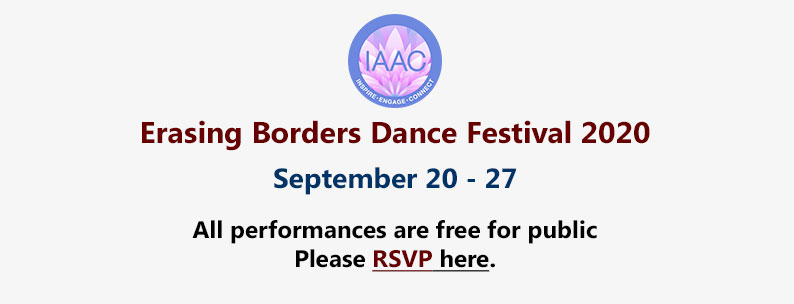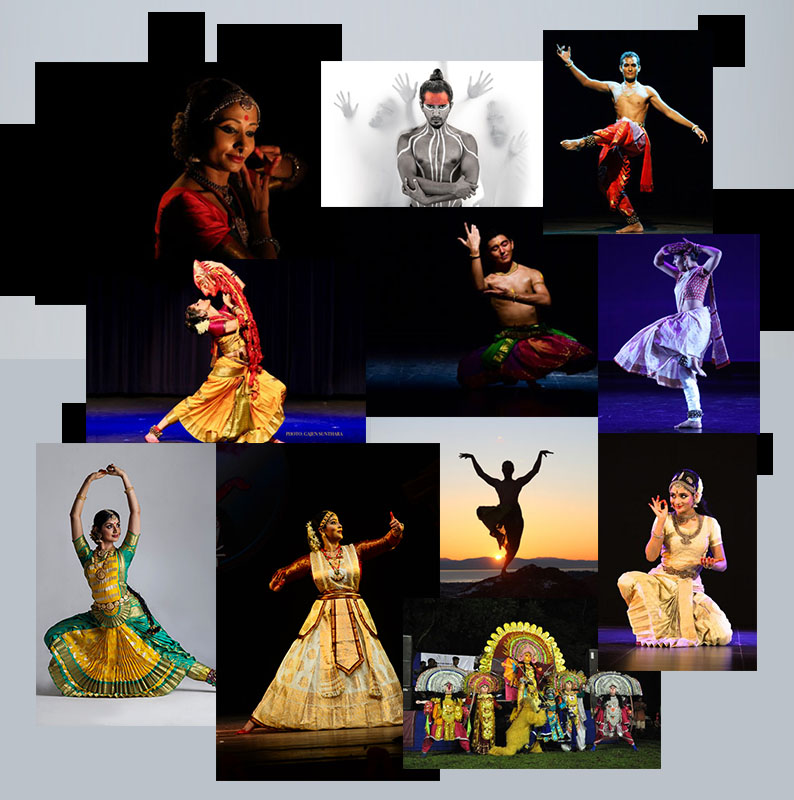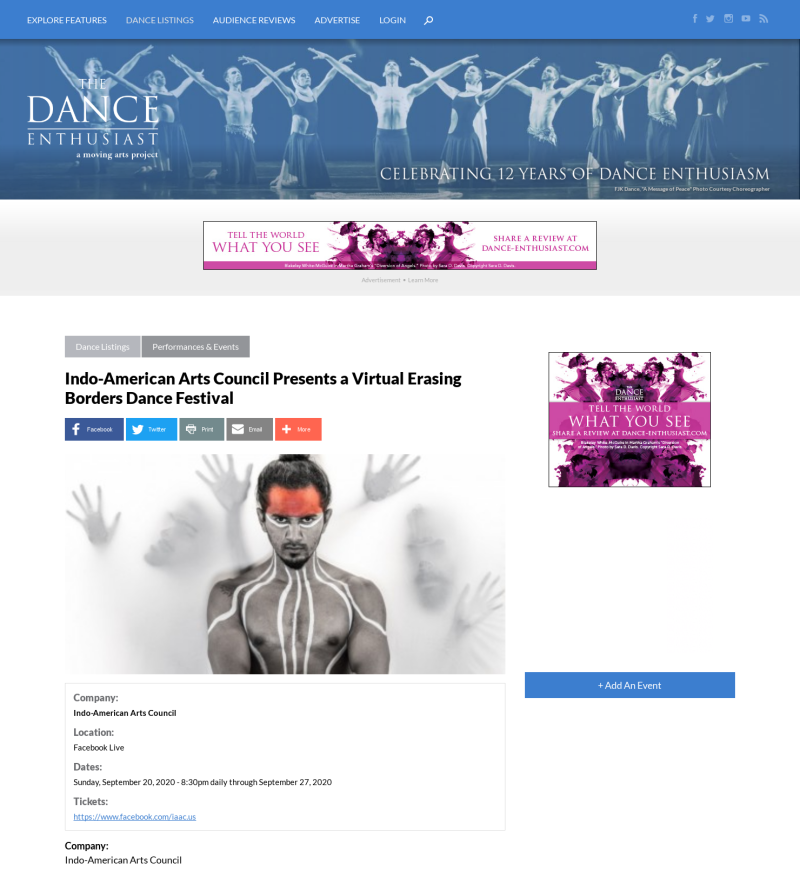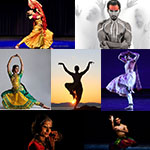
Erasing Borders Dance Festival 2020
Schedule
Shambhu Nath Karmakar/Ashpara Care Club—Purulia Chhau
Neha Mondal Chakravarty/Kalakshetra Bharatanatyam
Krishnakshi Kashyap—Sattriya
Ganesh Vasudeva—Bharatanatyam
Divyaa Unni—Bharatanatyam
Arun Mathai—Bharatanatyam
Sandhya Raju—Kuchipudi
Damir Tasmagambetov/Kalakshetra Bharatanatyam
Barkha Patel—Contemporary Kathak
Mesma Belsaré —Shilpa Natana
Vishwakiran Nambi—Contemporary
Workshops
Workshops by Nahid Siddiqui—Sufi Kathak
Radio Partners


Radio Partners


MESMA BELSARE
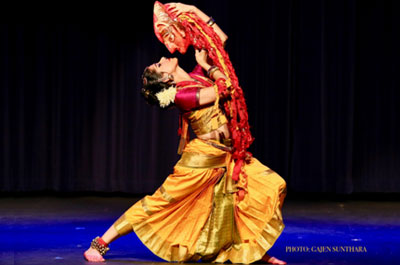
Mesma Belsaré is a dancer, painter and actor, described by The New York Times as "a tour de force...a true act of transcendence...", "as mesmerizing as staring into the heart of a fire" by The Dance Current Magazine and possessing a "capacity for intense involvement" by The Hindu. Belsaré studied Bharatanātyam in India under Sri Shankar Hombal at the Kalāpadma Academy and under Padmashri Geeta Chandran at the Nātya Vriksha Academy of Performing Arts.
Belsaré is continuing her studies with Maya Kulkarni in New York City, and creating new dance works inspired by classical visual arts/architecture, Sanskrit literature and Greek mythology/philosophy. Her solo venues include The Lincoln Center (NYC), Asia Society (NYC), Alvin Ailey (NYC), The Lincoln Theater (Washington D.C.), Siri Fort (New Delhi), The Harbourfront Centre (Toronto, Canada), and MFA Boston among others.
Having studied Indian classical music and dance, painting, theater, and both Indian and European aesthetics, her work derives inspiration from performing and visual arts alike. Belsaré is also an art educator and curates educational programs based on contemporary art. She is recipient of the Cambridge Arts Council's Artist-Grant, the Government of India's Sāhitya Kalā Parishad scholarship for advanced training in Bharatanātyam and Indian classical music, and the New England Foundation for the Arts DANCE grant.
Invited artist-residencies and talks include Georgetown University (2019), UC Berkeley (2019), California Institute of Integral Studies (2019), Drexel University (2019), William Paterson University (2019), MIT Cambridge, MA (2019) and Harvard University, Cambridge, MA (2019/2010) among several others. More information is available at www.mesmabelsare.com.
Shilpa Natana (The Dancing Sculptures)
Choreographed by NYC-based Maya Kulkarni, Shilpa Natana (The Dancing Sculptures) is rooted in the Sanskrit texts: the Natyashastra, the Abhinayadarpana and the Shilpa Shastra. This dance-genre steps out of the traditional Indian classical repertory. Chola, Mathura and Gandhara sculptures in addition to the Ajanta cave paintings inspire not only the choreography, but also the āhārya (costume, hair and make-up) of the dancer. The New York Times describes the dance as a "virtuoso number".
The repertory includes a refreshing interpretation of Līlā Shuka’s verses from the classic Krishnakaranāmritam and a dance inspired by Ardhanārīśwara that establishes parallels between the half-Śiva-half-Umā iconography and the Nāsadīya Sūkta (Hymn of Creation) in the Rig Veda (c.1700 B.C.E.).
NEHA MONDAL CHAKRAVARTY
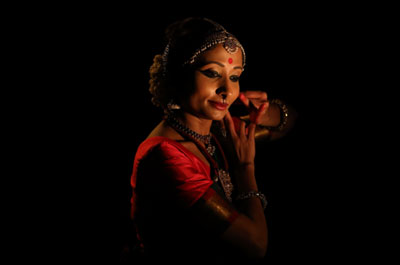
Hailing from India, New Delhi, Neha Mondal Chakravarty , is a Bharatanatyam performer , Teacher and Choreographer, who currently resides in Singapore. An alumna of kalakshetra Foundation, Chennai, Neha was trained and groomed by stalwarts like Shri A. Janardhanan, Sheejith Krishna, Smt. Jyolsana Menon and Ms. Leela Samson. Her experience with Kalakshetra’s repertory company, under the guidance of Leela Samson transformed her into a subtle and thinking Dancer. Neha worked as an empaneled “A” grade artist with the Ministry Of Information and Broadcasting, New Delhi.
Her inclination towards body awareness, also led her to train rigorously in jazz and contemporary dance. Junior and senior scholarships in Bharatanatyam were bestowed upon her, from NCERT and Ministry Of Culture. Having tied the knot with her soulmate, Neha moved to Kuala Lumpur in 2014. A strong will to impart quality training and expand the boundaries, thinking beyond the cliche led her into creating works that gradually kept maturing. She has to her credit, several collaborations, productions, solo presentations and choreographies. Neha has performed extensively in South East Asia, USA, UK and Europe. She now, trains serious practitioners of the art form while also performing and conducting insightful workshops.
SUKRITI
A woman who is born, like a seed within the depts of earth, that has millions of possibilities , waiting to start spreading its roots across the earth and reaching towards the sky. But not yet , as it awaits the perfect conditions like moisture which is karuna/compassion to nurture those possibilities. And then she rises like a million suns, protecting the world and its beings . A mother knows no bound , allowing the compassion to flow as her natural instinct . She also weeps silently when the human suffers!! And her wrath /fury , when the equilibrium is disturbed, has caused us to evolve or co-exist in a world that lacks compassion /empathy/ love.
The presentation shall revolve around Love/compassion/Empathy, an attempt to look through and find references from present and mythology, from sufi wanderers with the mysticism and philosophy on life, to Krishna, the charmer and forever longing for his love "Radha". The ultimate source of life "Devi" all pervading and an epitome of compassion. Join her as she attempts to highlight and bring back these virtues, which are gradually being forgotten.
VISHWAKRIAN NAMBI
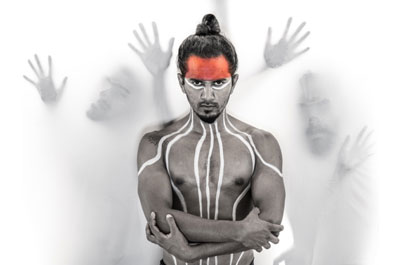
He is a performer, choreographer, dance film-maker and dance academic. Vishwa is the Director of LOKA Studio for Movement Practices and the driving force behind Vishwakiran Nambi Dance Education (VNDE). He was the principal dancer, head of training and one of the principal choreographers of 'Nritarutya Dance Company' for over 10 years.
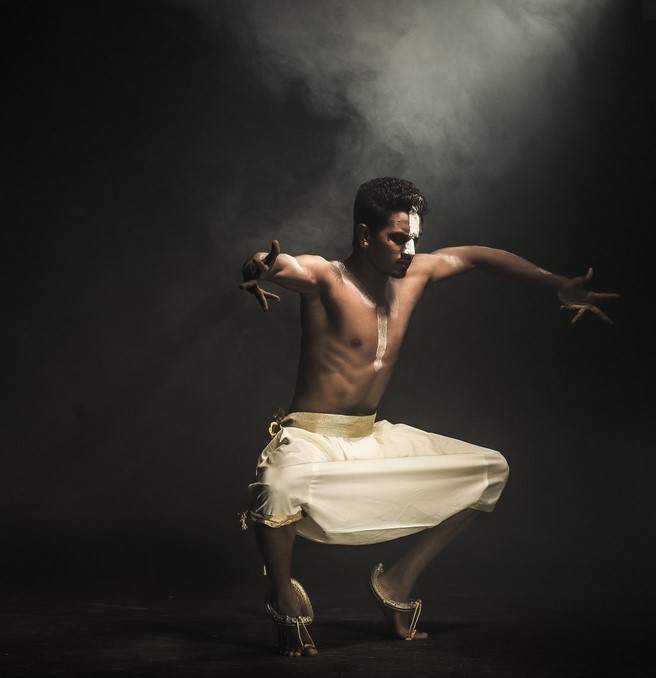
His training is diverse ranging from Indian classical forms to Indian folk and martial dance forms. Though his foundation is in contemporary dance and Bharatanatyam, he constantly trains and explores the folk dimensions of South Indian dance and trains extensively in martial forms.
He has been a solo performer for over 5 years now and has choreographed and presented his solo 'Stone Unturned' at the prestigious ADA Rangamandira in Bangalore as part of ADHYAYA 2017. He has, from then, choreographed multiple short pieces for Nritarutya and has gone on to create his own repertoire after he moved out of the Company. His vision is to explore the possibilities in Indian dance framework particularly with the vast folk landscape. His creations are mostly experiences of regional authenticities and existential peculiarities.
Pyre
Choreographer:
Vishwakiran Nambi
Dancers:
Niranjan Harish
Shreya Deshpande
Shruti Suresh
Sonal D'Souza
Jessiya K George
Kalpana Devaprasad
Thejas Gowda
Jean Fladberg Rose
Vishwakiran Nambi
Music:
Niranjan Harish
Lights:
Lekha Naidu
Costumes:
Sushma Nair and Rashmitha Gowda
Interview compilation and video editing:
Roshan Sylvester
Performance video:
Courtesy Sarvam Art Festival curated by Deepak MP
Miscellaneous dance footage:
Gomtesh Upadhye
VNDC
Camera, Editing and Co-direction:
Roshan Sylvester
Stills and videos:
Courtesy Radhika Gangaraj, Kirthi Kumar and Nritarutya
ARUN MATHAI
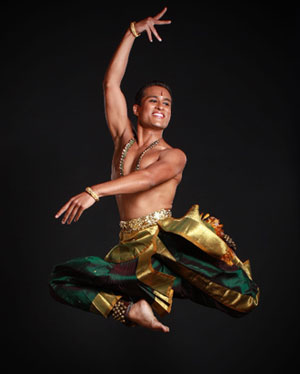
Arun was first exposed to Bharatanatyam while watching his older sister in class, and would often imitate the moves he witnessed, using the coffee table as his stage. Encouraged by his parents he started studying at Kala Vandana Dance Center, in San Jose, California, under the rigorous but loving guidance of his guru, Smt Sundara Swaminathan.
After obtaining his BS in Business Administration Arun joined LA-based Blue13 Dance Company and soon became a principal dancer. He also began traveling abroad to study with respected teachers and perform. In addition to his guru, some of the renowned instructors Arun studies with include: Smt KP Yasodha, Smt Rama Vaidyanathan, Smt Bragha Bessell, Sri Hari Padman, and Smt Viji Prakash.
Currently a freelance artist, Arun is also the Budget Manager at LACMA, is pursuing his MBA at UCLA Anderson, and is a part-time lecturer at USC's Glorya Kaufman School of Dance.
Shivoham
Based on an excerpt from the Skanda Purana, Shivoham, choreographed by Smt. Rama Vaidyanathan and composed by Sri GS Rajan, uses the idiom of dance to experience the presence of Lord Nataraja in the body and soul. “Jeevaha Shivaha. Shivo Jeevaha.” Shiva lives in every soul. Shiva is existence.
Shiva is synonymous with the fires of dissolution, but also the primordial drumbeat of creation. While we see both around us on a daily basis, it is hard not to focus solely on the negative, especially in the US, where racially motivated acts of violence happen every day. Just as Shiva maintains balance through the cycles of destruction and creation, we have the ability to overcome the violence of racism and police brutality through protest and social activism. Just as Shiva destroys in order to create, we have the power to dismantle systems of oppression in order to create a more just future. Shiva lives in every being. We are Shiva.
DAMIR TASMAGAMBETOV
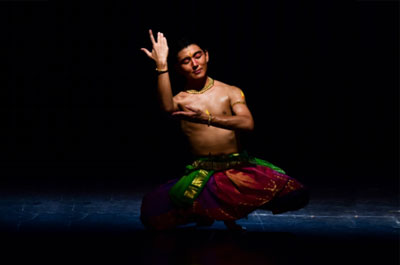
Damir Tasmagambetov originates from the city of Almaty, Kazakhstan - located in the heart of Central Asia. Damir holds a Bachelor and M.A degree from two Universities of Dance - one for each discipline in their respective country of origin. He completed his studies at the Kalakshetra Foundation with a 1st class Diploma in Bharatanatyam. Following this he continued to expand his knowledge in Indian Classical Dance by joining The University of Madras to complete his master’s degree in Bharatanatyam.
In 2017 he graduated from the University of Madras with a 1st Class Diploma, Master of Arts in Bharatanatyam.In 2017, the Indian Council For Cultural Relations (ICCR) selected him to be Empanelment in the ICCR’s Reference Panel of Artistes. By special invitation Damir was selected to become a Member of the International Dance Council(CID) under UNESCO in Paris, France.As an extremely passionate dancer, Damir has worked hard to stay within the dance field.
He has given numerous solo and group performances at major dance celebrations and many prestigious platforms in India, Kazakhstan, Kyrgyzstan and the USA.Currently based in Brooklyn, New York, Damir is committed to spreading a deep understanding of Indian classical traditions through teaching within the USA. As an educator he has given lectures, demonstrations and workshops in both museums and schools throughout the NYC area. He strives to train the next generation of Bharatanatyam artists that share his passion and joy for the art, helping them develop the skills necessary to explore new possibilities within this art in today’s world.
Invocation: Ganapathi Stuthi
Bala Ganapathi is an aspect of the Hindu God Ganesha, the elephant-headed of wisdom and fortune, depicted as a child. The beautiful and beloved son of Shiva and Parvathi, and who’s brother is Lord Muruga. You are destroyer of all the obstacles, and you are full of mercy and compassion. We bow to you O’Lord Bala Ganapathi!
Main piece: Kumarasambhavam
Kumarasambhavam is widely regarded as one of Kalidasa"s finest works. This keertanam it is a extract from kumarasambavams 7th Sarga, which describes Lord Shivas preparation for marriage. Ragam: Bibhas Talam: Adi Music composer : Sree Madhup Mudgal Choreography: Smt. Leela Samson
Conclusion: Shanti Path - mantra for the Well being of all.
Those verses taken from Shanti Path, which is a mantra of Peace, Harmony and Happiness. May peace radiate there in the whole sky as well in the vast ethereal space everywhere. May peace flow over the whole universe. And may there always exist in all peace and happiness.
BARKHA PATEL

Barkha is a kathak dancer, choreographer, educator, and the Artistic Director of Barkha Dance Company. A touring artist, Barkha has performed at dance festivals in India to Jacob’s Pillow Inside/Out series in the U.S. The New York Times has claimed, “The brilliant virtuosity and bewitching charm of Barkha helped us forget that tape was second best [in lieu of live musicians]” when reviewing her evening length solo.
Barkha has completed a choreographic fellowship with Jersey Moves/New Jersey Performing Arts Center. Currently she is working on her first, full evening ensemble work called Mukta, A Woman Liberated. Barkha received a 2020 Fellowship from the New Jersey State Council on the Arts and is a mentee of Dance/USA Institute for Leadership.
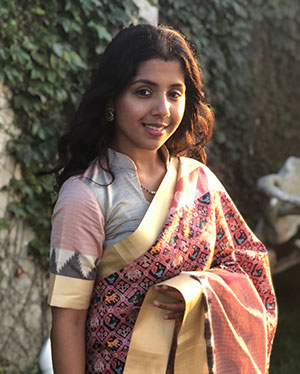
Barkha teaches kathak to young and adult students in NYC/NJ and now across the world via Zoom. Barkha co-founded a Kathak meetup group, an inclusive space for Kathak dancers to practice and discuss crucial topics to the art form.
Engaging with my South Asian cultural heritage and history, I invite the spirit of inquiry to examine the complex dualities I encounter as an Indian woman born in India and raised in New York.
Pad-Yatra
Pad-Yatra was inspired by a week-long walking pilgrimage (pad-yatra) Barkha participated in from her hometown in Gujarat to the temple of Goddess Bahuchara.
This work is a response to the duality Barkha experienced while on the yatra. While a community gathered to pray to Maa Bahuchara to be included in her merciful glance, several members of the same community shunned interactions with the descendants of the Goddess, transgenders or hijras, creating a separateness.
GANESH VASUDEVA
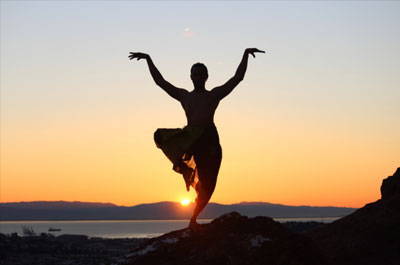
Ganesh Vasudeva has been training in Bharatanatyam for more than 30 years. In the past few years Ganesh has choreographed and presented his own work to critical acclaim. More information can be found for Ganesh at https://www.ganeshvasudeva.com/
Descent of the Ganges
Hindu mythology says Ganges, The river goddess Ganga, originally flowed through the heavens. She was brought to earth by devout Sage Bhagiraths. Goddess Ganga agreed to flow to earth for the benefit of mankind but warned her torrential currents would wash the world away. Upon Bhagirath's request, Shiva put his matted hair in the path of the heavenly river. Ganga in her arrogance, tried to sweep Shiva away. Upon realizing this, Shiva tied her up in his deadlocks. Mythology tells us that upon the request of Bhagiratha, Shiva splits Ganga into many streams. However, in this rendering, the story is imagined differently. Ganga upon realizing that she cannot sweep Shiva away with force, tries her feminine charm on him. She slowly trickles down covering his eyes, nose. When she is about to descent on his lips , Shiva realizes Ganga’s pranks, and lets her off gently from his matted locks.
In this charming Padam, a young maiden curious about Krishna asks her friend for details about him. She says what kind of man is he? Tell me everything you know about him.
In this Javali, a young bride chides Cupid for shooting flower arrows at her when her beloved husband is not at home.
DIVYAA UNNI
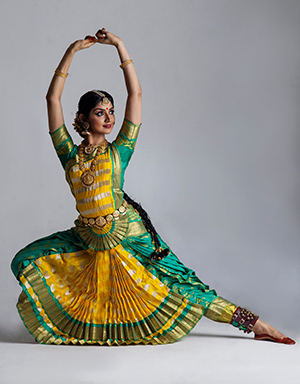
Smt. Divyaa Unni is an internationally recognized dancer, teacher and choreographer. She started learning dance at the tender age of three from the highly respected and diverse dance gurus; Kalamadalam Gopinath and RLV Anil Kumar. She was crowned “Kalathilakam” in the annual state-wide youth festival conducted by the Government of Kerala in the year 1990 and 1992. Divyaa's dance was featured in Doordarshan at the age of 6 and subsequently she presented dance recitals of Bharatanatyam, Mohiniyattam and folk dances every year from 1987 to 1994. Her potential in acting was realized due to her achievements in dance following which, at the age of 13, she was offered the leading role in a Malayalam movie in the year 1995. Subsequently, Divyaa, has acted as a female lead in more than 50 movies, including Tamil, Kannada and Telegu movies. Some of her recent and notable productions are “Tara” which was part of the Panchakanya project by Tat Tvam Asi sabha in Austin, Texas (2017); and “Vande Janani - celebrating motherhood” and Thousand names of a Goddess (2019). Divyaa is known to move the audience with her Abhinaya style of Dance, without losing the technical purity of Bharatanatyam.
It's a new beginning
Humans consider themselves the most significant creation of God. Yet, human greed has constantly overpowered this blessing as humans have looted, disrupted and continuously destroyed this planet.
Surrounded by the fearful dark clouds of uncertainty humans cease to introspect. From deep within shines a divine light, the form of Goddess Kalika -- the destroyer of evil forces. The female energy that represents the fullness of time -- the changing aspect of nature. Her hands usually carry a demon head and sword, only this time holding neem leaves and holy water. She starts to dance around the world sprinkling holy water on the entire creation. Glancing deep into the eyes of the introspective human, she compassionately sprinkles the holy water on him. White flowers showers from her hand onto his head, on to the rivers, trees, plants and animals. Back in tune with the divine melody and realization; man once again starts to live in harmony with nature.
SANDHYA RAJU

Sandhya Raju is a Kuchipudi dancer from Hyderabad. She has learnt the dance form from the legendary dance maestro Padma Bushan Dr. Vempati Chinna Satyam and his senior disciple Shri Kishore Mosalikanti Garu. She presented Kuchipudi as part of her Guru’s troupe as well as a solo artist.
She is the founder director if Nishrinkala Dance Academy in Hyderabad. Beyond Kuchipudi dance, she has also explored other mediums of artistic expression through her acting in three short films. Her most notable one is “ Natyam” on YouTube. She has acted in a Malayalam Feature Film and is currently filming for a dance based feature film where she plays the lead character of an Indian Classical Dancer.
GOVARDHANA GIRI DHARA
This is a Kuchipudi Tharangam composed by saint Narayana Theertha and choreographed by Padma Bushan Guru Vempati Chinna Satyam Garu.
It is set to Raagamalika and Adhi talam.
As a quintessential Kuchipudi solo presentation, the Tharangam is the main act or Crux of the recital.
The song is in praise of Lord Krishna, who’s various attributes are described and praised.
Primarily as the one who lifted the Govardhana Mountain with his little finger, to provide shelter to his community against the angry wrath of Lord Indira, who summoned floods and storms against Brindavanam as they chose to do annual prayers to the mountain gods instead of Him.
This story which is enacted in detail is preludes by two more joyous tales of Krishna’s life in Brindavanam.
One episode describes his love of milk and how he steals it greedily under the watchful eyes of his mother Yashodha.
Another describes the legend of how he stole the beautiful Gopikas clothes and demands they come out of the water nude and pray to him. Symbolising that he teaches the Gopikas that God doesn’t differentiate man or women and there should be no shame or vanity regarding the human body.These episodes are followed by beautiful yet ancient dance jathis using some of the oldest unique steps to the Kuchipudi classical style.
The piece concludes with a traditional dance on the brass plate .
KRISHNAKSHI KASHYAP
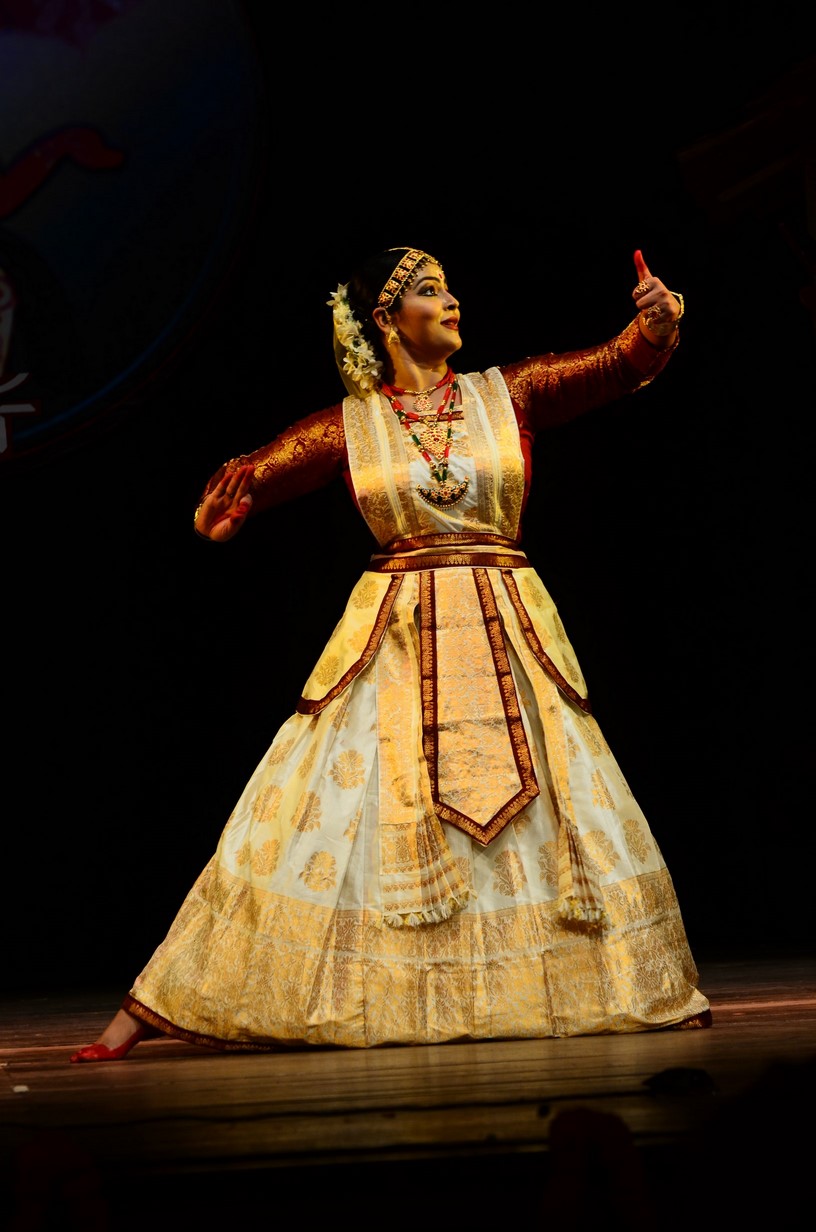
Krishnakshi Kashyap is an Indian Sattriya performing artiste, educator, choreographer, cultural ideapreneur and a social entrepreneur. A recipient of the Young Talent Artiste Award by NEZCC, Ministry of Culture, Govt Of India, she is also conferred with the Dalmia Cement Young Achiever's Award 2020 for her exceptional achievements in the field of Art and Culture. An avid performer of Sattriya, she now engages herself in promotion and propagation of Sattriya Dance, the 600 years old living tradition of Assam, a state in North East India. Trained under renowned Gurus Shri Ramkrishna Talukdar, Shri Jatin Goswami and Smt Indira P P Bora, Krishnakshi has performed Sattriya on various prestigious platforms across the country. She is a graded artiste under Prasar Bharati, India's largest public broadcasting agency. Under her initiative ' Empowerment through Arts', she engages herself in the training of Sattriya Dance to the less privileged, adding colour to their lives and empowering them. She has used the power of this dance form as a medium of empowerment for promising underprivileged young girls of different places with training programmes and performances. In an attempt to spread awareness about Sattriya, Krishnakshi has started another initiative, 'Promote the Heritage Culture - Sattriya' and also conducts Sattriya workshops and online classes for students across the globe.
RAMA NIRANJANA
The abhinaya piece ‘Rama Niranjana’ is based on the 'Gunamala' , which is a scripture written by the social, cultural and religious reformer Mahapurush Srimanta Sankardev within one night at the request of Koch king Nara Narayan in 1552. It is an abridged and condensed version of the entire ten cantos of the 'Bhagawat Purana' one of Hinduism's great Puranas. The literature speaks of Lord Krishna and Lord Rama as different manifestations of the same Supreme Almighty, the philosophy that forms the core of the Bhakti culture in Sattriya. The Lord is described as the one from whom all the world accrued, the destroyer of iniquity of the demons, the charmer of the Gopees, the one who sang the Vedantic verses and played the flute and the one who is the Master of the Universe. This dance depicts various instances of Lord Krishna’s life - the lifting of Govardhana Parbat, Kaliya Domon and also depicts the ten incarnations of Lord Vishnu popularly known as the Dasavatar.
ROJAGHORIA SAALI
This will be followed by ‘Rojaghoria Saali’ which is a pure dance number in ‘Lashya’ or feminine style of Sattriya Dance . In the Shankarian and the post Shankarian era, the Ahom kings patronised the Sattriya culture and Sattriya dance and dancers were invited to perform in the king's court. The dancers were initially reluctant to perform the traditional dance outside the Sattras (monasteries) but unable to deny the royal command they performed a reformed and revised version of the traditional form in the king's court, thus preserving the original form within the four walls of the Sattras. Thus, emerged the Rojaghoriya Saali where ‘Roja’ means king and ‘ghor’ means house (court/palace), thus referring that this dance was performed in the king's palace/court, sometime during the Ahom era in Assam.
SHAMBHU NATH KARMAKAR
(Ashpara Care Club Chhau Group)
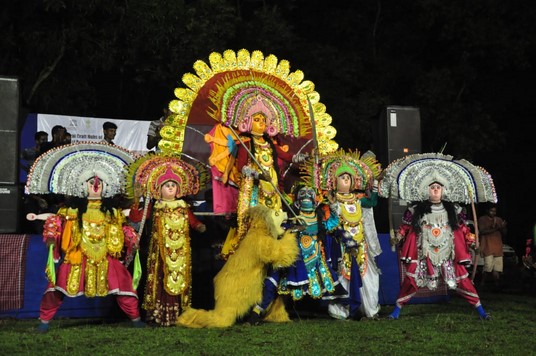
Shambhu Nath Karmakar is a Purulia Chhau artist trained int his traditional martial and acrobatic dance form under Dhananjay Mahato and has received national scholarship in dance from Ministry of Culture, New Delhi. He is involved in Purulia Chhau performance, training, workshops, exhibitions, and competitions. He and his group has been invited to various national and international festivals including Japan, Srilanka, Bangladesh and others. He has established Seva Jatna Chhau Institution to teach the youth this martial dance form and to deepen their connections to their cultural roots.
MAHISASUR MARDINI
A traditional piece in the Purulia Chhau repertoire, this ensemble number introduces the all-powerful Goddess Durga (demon Mahisasur slayer) and her family as she vanquishes the evil buffalo demon. Each of the members of the family, Gods Ganesha, Kartik with his peacock companion, Shiva, Goddesses Laksmi, Saraswati, and Durga and her lion companion enter the playing space, supported by the percussion of the Dhamsa drum and the shehnai pipe, and show off their acrobatic process through leaps, jumps, and somersaults. With the buffalo demon’s introduction, Goddess Durga activates her omnipotent energy to tackle the demon. After a display of their strengths, good persists over evil and the buffalo demon is succumbs. The divine family can now assemble and shower their blessings on the earthly devotees. This piece is popular in the Bengali Durga puja circuit in the months of September and October.
Ashpara Seva Jatna Chhau Prashikshan Kendra
Troupe Director/Choreographer: Shambhu Nath Karmakar
Videography: Tirtha Mitra
Musicians:
(Dhol Drum)
Sristidhar Sahis / Tarapada Mahato
(Dhamsa Drum)
Asit Mandi / Santos Majhi
(Sanai/Shehnai)
Birhaspati Kalindi
(Merakos)
Rabi Tantubai
Dancers:
As Ganesha
Adalat Sahis
As Kartika
Tipu Singh
As Durga
Shambhu Nath Karmakar
As Mahisasur Demon
Daktar Sahis
As Lion
Arun Karmakar
As Laxmi
Sudhir Majhi
As Saraswati
Mansaram Singh Sardar
As Mahisasur's Aides/ Demons:
Lakhipada Karmakar
Rabindra Nath Mahato
Ashutos Majhi
Narayan Karmakar
NAHID SIDDIQUI
(Sufi Kathak Workshops)
Sept 27, 2020, Sunday, 10:30AM EDT
Buy TicketCelebrated Kathak artist Nahid Siddiqui will share her story, her journey through dance and her inclination toward Sufism that underlies her practice and philosophy. In this workshop, all attendees will gain insight to Nahidji's Sufi-inclined Kathak repertoire. There are no prerequisites and all are welcome!
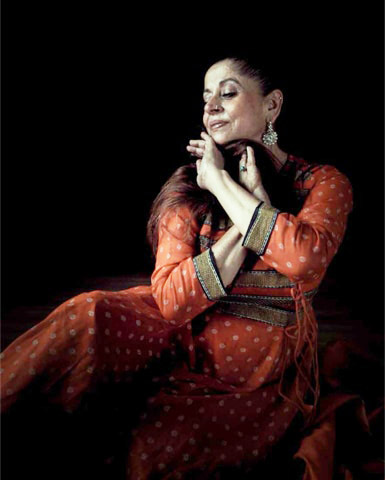
Kathak artist Nahid Siddiqui is renowned for depicting sublime sufi narratives through her emotive expressions and exquisite gestural language.
Central to what she refers to as 'gayeki ang gharana' is the notion of sangat (harmonious music), riaz (practice), pace and alignment. At the same time, her abhinaya or facial gestures create a nuanced and refined study of sentiment and emotion; a rare and celebrated dance purist in pursuit of choreographies of serenity.
Siddiqui chooses improvisation over fixed repertoires, allowing her the freedom to paint, as she puts it, 'on the canvas of space'. Once a form is registered in the body, she believes that a dancer must not become a slave to its material but, instead, allow the form to aestheticise the body and evoke its memories.
Siddiqui merges with the beat and pulse of her audience. Her abhinaya is more than mimetics and literal meanings of poetic renditions. Rather, it serves to heighten our awareness of even mere tinkering or sounds of silence that breathe life into her form and repertoire.
For Siddiqui, this is in line with the ethos of subcontinental Sufism, and to quote Siddiqui, ‘one communicates with one's higher self because Radha-Krishna, Heer-Ranjha are within us and when we address them, they appear'. Her sufianic approach to the kathak form is central to her life and craft. She believes that 'all artistic expression is based on sufi principles as artists do not believe in borders, instead they strive to unite people'. Her thematics celebrate religiosity, mysticism and folklore as a beacon of peace, harmony and diversity.
She performs in a manner where her experiences allow for such intuitive improvisation that shifts from nowhere into a meditative nothingness; a place where we can collectively reflect on shared truths and stories.
Artistic Process
In late 2019 and early 2020 Erasing Border Dance Festival planned to have a "normal" presentation of varied and wonderdul performers in 2020 at Alvin Ailey Citigroup Theatre on Sept 27.
But like the rest of the world, we too got humbled by the global pandemic. Even as our curators kept planning and selecting from a fabulous pool of artists, we kept checking the performing arts industry and hoping for crucial decision, guidance, a flattened curve and a back-to-normal life. That is still to happen. In mid June we decided to move the festival online. This has its own artistic challenges, but we believe it also opens up many possibilities. Our artists this year are from across the world, representing many of India's dance forms, and bringing them together on an online platform was the most responsible and the most exciting way of showcasing their work. We hope you enjoy!

The following guidelines were sent to artists in the pre-pandemic phase of 2020. Much has changed since then. See '2020 Artistic Process' for how the curators reworked the festival with the selected artists.
Curatorial Guidelines
We are only taking in digital applications this year.
You can submit solos, duets or larger groups.
Typically, an artist performs for 8-13 min.
Your video is the most important part of your application. An impressive video can catch the eye of the curator and make your performance memorable. When submitting a video, make sure the video is well-lit and appropriately edited for maximum impact. Below are some tips for editing your videos:
- The dancer should be clearly visible in the video.
- The video(s) you submit should be of the work that you propose to perform at the festival, and should reflect exactly what you will plan to perform that evening. In case the video exceeds the timing, please indicate time markers in your application for the segment/s you are proposing.
- You may submit up to 2 additional alternative videos with your application. Each video should follow ideally be less than 13 minutes.
- Dance works are often better appreciated when placed in context. We suggest that you include a commentary/explanation of process in the
Details of the Proposed Work
section of your application. - Live explanations (i.e. spoken commentaries on your video) will be counted as part of the timing of the total presentation, so you may prefer to send in a written explanation.
- The video you submit should be include the complete, continuous work you intend to perform, if selected. It is imperative for the curators to see the entire work, because our decision making involves thinking through how all the selected works (by different artists) will collectively form a unique, cohesive experience for our audience. An excerpt put together with bits and pieces from different parts of a work or different works WILL NOT BE ACCEPTABLE for the application.
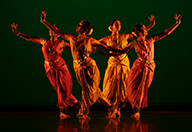
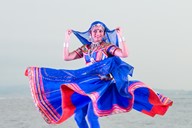
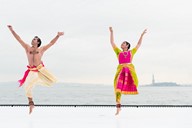

The Erasing Borders Dance Festival of The Indo-American Arts Council (IAAC) invites applications from dancers, dance companies and choreographers across the world to present works of artistic excellence sharing movement, heritage and inspiration from the Indian subcontinent. The festival is curated for the New York City public.
Extended Deadline for applications: March 06, 2020
Because of server issues the deadline for applications will be extended to March 6.
We are looking for:
- Exciting works and new voices from within traditional Indian dance.
- Original works in multiple or new vocabularies and forms deriving from or relating to the traditions of Indian dance.
- Works that are challenging or critically thinking on their own terms.
Professional works of 8-20 minutes duration (you can submit multiple works for us to consider).
Requirements:
- Completed Application Form, which will include a place for you to send us a link to the performance piece you want to showcase at the festival.
- Video: Applicants need to submit the entire video recording of the proposed works (not excerpts or sampling of past works).
- Only professional level performances will be considered for the festival.
- Non-refundable application fee of $20.
HOW TO SUBMIT:
We are only taking in digital applications this year.
- First, review the Curatorial Guidelines we have compiled. These guidelines will help you submit a strong application which catches the eye and interest of our curators.
- Next, complete your application form. Bear in mind that you will not be able to save your application and come back to it later. So, it is recommended that you first draft your answers in a separate document, and then enter them on this online form in one sitting.
- Pay your $20 application fee through PayPal
 (using any credit card) Click here >>
(using any credit card) Click here >> - If you have any questions, check the Frequently Asked Question (FAQ). We keep updating this FAQ as new questions are received. If the FAQ does not address your questions, you can email us via this Inquiry form. Please note that we will only respond to questions that have not been addressed in the FAQ, so make sure to check the FAQ first!
- New policy due to unforeseen circumstances: Invited dancers are requested to organize their own visas and airfares to the Erasing Borders Festival of Indian Dance 2020.
FOR IMMEDIATE RELEASE:
September 8, 2020
Contact: Michelle Tabnick, (646) 765-4773, michelle@michelletabnickpr.com
Indo-American Arts Council
Presents a Virtual
Erasing Borders Dance Festival
September 20-27, 2020
All performances are FREE to the public but please RSVP here.
Watch LIVE on  and
and 
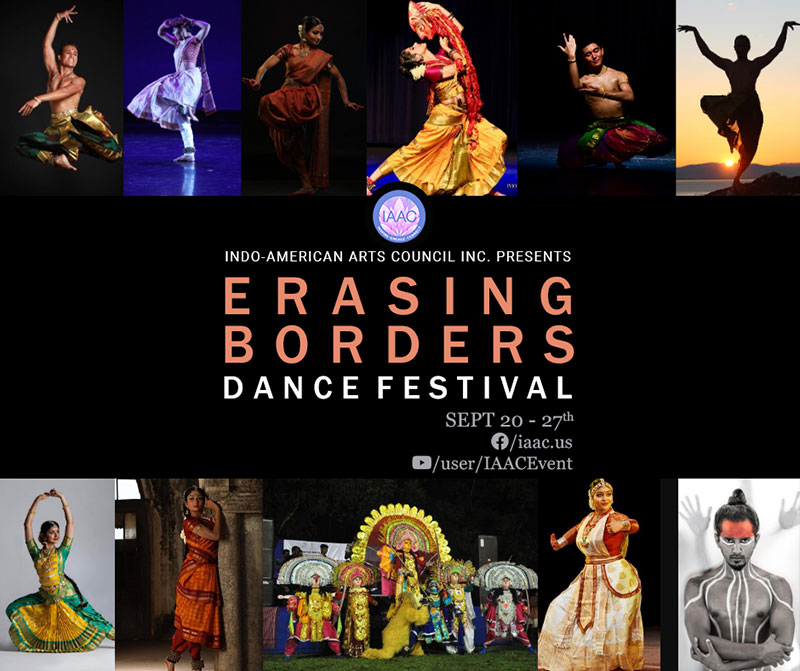
Indo-American Arts Council proudly presents the Erasing Borders Dance Festival from September 20-27, 2020 at 8:30pm EST each day for free on Facebook Live at facebook.com/iaac.us. For the twelfth year of the Erasing Borders Dance Festival, IAAC has expanded the event. For the first time, eleven artists trained in Indian dance forms from across the world will be brought together in a virtual borderless festival. Details are available at iaac.us/erasing-borders-dance-festival-2020/.
Deepsikha Chatterjee, Festival Director stated, “Moving to a virtual format has its own artistic challenges, but we believe it opened up many possibilities. Our artists are from across the world, representing many of India’s dance forms. Bringing them together on an online platform was not only the most responsible and exciting way of showcasing their work but also displaying the virtuosity of diversity.”
Sunday, September 20, 2020
Shambhu Nath Karmakar/Ashpara Care Club (Purulia Chhau)
Monday, September 21, 2020
Neha Mondal Chakravarty (Kalakshetra Bharatanatyam)
Krishnakshi Kashyap (Sattriya)
Tuesday, September 22, 2020
Ganesh Vasudeva (Bharatanatyam)
Wednesday, September 23, 2020
Divyaa Unni (Bharatanatyam)
Arun Mathai (Bharatanatyam)
Thursday, September 24, 2020
Sandhya Raju (Kuchipudi)
Friday, September 25, 2020
Damir Tasmagambetov (Kalakshetra Bharatanatyam)
Barkha Patel (Contemporary Kathak)
Saturday, September 26, 2020
Mesma Belsaré (Shilpa Natana)
Sunday, September 27, 2020
Vishwakiran Nambi (Contemporary)
Workshops by Nahid Siddiqui (Sufi Kathak)
The Festival dancers, turned away from traditional performance spaces, take the time to reflect, activate, and energize through other forms of healing. Mesma Belsaré seeks inspiration in the fluid lines of India’s ancient architecture while Singapore-based Neha Mondal Chakravarty meditates on a tiny seed sprouting into the fullness of womanhood in Bharatanatyam. Vishwakiran Nambi collects his contemporary group in the urbanscape of Bengalaru to use their bodies in deeply felt and original ways. Arun Mathai draws power and energy from The Great God Shiva against the Black Lives protests in US for his Bharatanatyam performance. New Yorker Damir Tasmagambetov from Kazakhstan, trained in Kalakshetra Bharatanatyam in India bridges many cultures, and concludes his creative presentation through a prayer for Shanti or peace. US based Kathak dancer Barkha Patel is nourished by her week-long walk in Gujarat in prayers for Goddess Bahuchara Maa, a deity for the transgender community in India. Divyaa Unni in Bharatanatyam depicts the unusually calm Goddess Kalika, who appears with neem leaves and holy water this one time to bring balance and tranquility back. Kuchipudi dancer Sandhya Raju’s solo presents Lord Krishna, the one who lifted the Govardhan mountain to provide much needed shelter. Her Tarangam dance piece on a brass plate, built through years of training provides much needed charm. Ganesh Vasudeva’s Bharatanatyam depicts the Ganga River flowing down from the icy Himalayas, believed to be Lord Shiva’s locks of hair, into nourishing rivers and streams. Assam’s Sattriya dancer and social entrepreneur Krishnakshi Kashyap reflect on the centuries old meditative performances of the region while Purulia Chhau artist Shambhu Nath Karmakar marches with his ensemble in the traditional acrobatic martial art form to show Goddess Durga vanquishing Mahishasur, the bull demon to restore peace and prosperity.
About the Performances
Mahisasur Mardini, performed by Shambhu Nath Karmakar
A traditional piece in the Purulia Chhau repertoire, this ensemble number introduces the all-powerful Goddess Durga (demon Mahisasur slayer) and her family as she vanquishes the evil buffalo demon. Each of the members of the family, Gods Ganesha, Kartik with his peacock companion, the great god Shiva, Goddesses Laksmi, Saraswati, and Durga and her lion companion enter the playing space, supported by the percussion of the Dhamsa drum, dhol drum, and the shehnai pipe. They show off their acrobatic process through leaps, jumps, and somersaults. Then comes the buffalo demon with his retinue of minor demons causing much destruction. Goddess Durga activates her omnipotent energy to tackle the demon. After a display of their strengths, good prevails over evil and the buffalo demon and his aides succumb to divine power. The Godly family can now assemble and shower their blessings on the earthly devotees. This piece is popular in the Bengali Durga puja circuit in the months of September and October.
Sukriti, performed by Neha Mondal Chakravarty
A woman who is born, like a seed within the depths of earth that has millions of possibilities waiting to start spreading its roots across the earth and reaching towards the sky. But not yet, as it awaits the perfect conditions like moisture which is karuna/compassion to nurture those possibilities. And then she rises like a million suns, protecting the world and its beings. A mother knows no bound, allowing the compassion to flow as her natural instinct. She also weeps silently when the human suffers! And when the equilibrium is disturbed in a world that lacks compassion/empathy/love we learn to evolve or co-exist. The presentation shall revolve around Love/compassion/Empathy, an attempt to look through and find references from the present and mythology, from sufi wanderers with their mysticism and philosophy on life, to Krishna, the charmer and forever longing for his love “Radha.” The ultimate source of life “Devi”, all pervading, and an epitome of compassion. Join her as she attempts to highlight and bring back these virtues, which are gradually being forgotten.
Rama Niranjana, performed by Krishnakshi Kashyap
The abhinaya-mimetic piece ‘Rama Niranjana’ is based on 'Gunamala', a scripture written by the great saint, poet, scholar and social, cultural and religious reformer Mahapurush Srimanta Sankardev in one night at the request of Koch king Nara Narayan in 1552. It is an abridged version of the ten cantos of the 'Bhagawat Purana'- one of Hinduism's eighteen great Puranas, where the poet recounts incidents from Lord Krishna's life. It will depict mythological stories—the lifting of Govardhana mountain, overthrowing Kaliya snake and the ten incarnations of Lord Vishnu. This will be followed by two traditional dance types of Sattriya, the Ojapali and the Bhortal-cymbal dance. The music for this dance is specially recorded for performance using traditional musical instruments like the Khol, Flute, Cymbals and Violin.
Rojaghoria Saali, performed by Krishnakshi Kashyap
This is a pure dance number in ‘Lashya’-feminine style of Sattriya Dance. In Shankardeva’s era and later, Ahom kings patronized the Sattriya culture. The dancers were initially reluctant to perform the traditional dance outside the monasteries but accepted the royal command. They reformed and revised a version of the traditional form for the King's court, thus preserving the original form for the monasteries. Thus, emerged the Rojaghoriya Saali where ‘Roja’ means king and ‘ghor’ means house (court/palace), revealing that this dance was performed in the king's palace/court, sometime during the Ahom era in Assam.
Descent of the Ganges, performed by Ganesh Vasudeva
Hindu mythology says Ganges, The river goddess Ganga, originally flowed through the heavens. She was brought to earth by devout Sage Bhagiraths. Goddess Ganga agreed to flow to earth for the benefit of mankind but warned her torrential currents would wash the world away. Upon Bhagirath's request, Shiva put his matted hair in the path of the heavenly river. Ganga in her arrogance, tried to sweep Shiva away. Upon realizing this, Shiva tied her up in his deadlocks. Mythology tells us that upon the request of Bhagiratha, Shiva splits Ganga into many streams. However, in this rendering, the story is imagined differently. Ganga upon realizing that she cannot sweep Shiva away with force, tries her feminine charm on him. She slowly trickles down covering his eyes, nose. When she is about to descend on his lips, Shiva realizes Ganga’s pranks, and lets her off gently from his matted locks.
In this charming Padam, a young maiden curious about Krishna asks her friend for details about him. She says what kind of man is he? Tell me everything you know about him.
In this Javali, a young bride chides Cupid for shooting flower arrows at her when her beloved husband is not at home.
It’s a New Beginning, performed by Divyaa Unni Humans consider themselves the most significant creation of God. Yet, human greed has constantly overpowered this blessing as humans have looted, disrupted and continuously destroyed this planet.
Surrounded by the fearful dark clouds of uncertainty humans cease to introspect. From deep within shines a divine light, the form of Goddess Kalika—the destroyer of evil forces. The female energy that represents the fullness of time—the changing aspect of nature. Her hands usually carry a demon head and sword, only this time holding neem leaves and holy water. She starts to dance around the world sprinkling holy water on the entire creation. Glancing deep into the eyes of the introspective human, she compassionately sprinkles the holy water on him. White flowers showers from her hand onto his head, on to the rivers, trees, plants and animals. Back in tune with the divine melody and realization; man once again starts to live in harmony with nature.
Shivoham, performed by Arun Mathai
Based on an excerpt from the Skanda Purana, Shivoham, choreographed by Smt. Rama Vaidyanathan and composed by Sri GS Rajan, uses the idiom of dance to experience the presence of Lord Nataraja in the body and soul. “Jeevaha Shivaha. Shivo Jeevaha.” Shiva lives in every soul. Shiva is existence.
Shiva is synonymous with the fires of dissolution, but also the primordial drumbeat of creation. While we see both around us on a daily basis, it is hard not to focus solely on the negative, especially in the US, where racially motivated acts of violence happen every day. Just as Shiva maintains balance through the cycles of destruction and creation, we have the ability to overcome the violence of racism and police brutality through protest and social activism. Just as Shiva destroys in order to create, we have the power to dismantle systems of oppression in order to create a more just future. Shiva lives in every being. We are Shiva.
Govardhana Giri Dhara, performed by Sandhya Raju
This is a Kuchipudi Tharangam composed by saint Narayana Theertha and choreographed by Padma Bushan Guru Vempati Chinna Satyam Garu. It is set to Raagamalika and Adhi talam. As a quintessential Kuchipudi solo presentation, the Tharangam is the main act or crux of the recital. The song is in praise of Lord Krishna, whose many attributes are described and praised. Primarily as the one who lifted the Govardhana Mountain with his little finger, to provide shelter to his community against the angry wrath of Lord Indira, who summoned floods and storms against Brindavanam as they chose to do annual prayers to the mountain gods instead of Him.
This story which is enacted in detail is preludes by two more joyous tales of Krishna’s life in Brindavanam.
One episode describes his love of milk and how he steals it greedily under the watchful eyes of his mother Yashodhara.
Another piece describes the legend of how he stole the beautiful Gopikas clothes and demands they come out of the water nude and pray to him. Symbolising that he teaches the Gopikas that God doesn’t differentiate man or women and there should be no shame or vanity regarding the human body. These episodes are followed by beautiful yet ancient dance jathis using some of the oldest unique steps to the Kuchipudi classical style. The piece concludes with a traditional dance on the brass plate mastered with many years of intense practice.
Invocation: Ganapathi Stuthi, performed by Damir Tasmagambetov
Bala Ganapathi is an aspect of the Hindu God Ganesha, the elephant-headed of wisdom and fortune, depicted as a child.
The beautiful and beloved son of Shiva and Parvathi, and whose brother is Lord Muruga. You are destroyer of all the obstacles, and you are full of mercy and compassion. We bow to you O’Lord Bala Ganapathi!
Main piece: Kumarasambhavam, performed by Damir Tasmagambetov
Kumarasambhavam is widely regarded as one of Kalidasa’s finest works. This keertanam is an extract from kumarasambavams 7th Sarga, which describes Lord Shiva’s preparation for marriage. Ragam: Bibhas, Talam: Adi, Music composer : Sree Madhup Mudgal, Choreography: Smt. Leela Samson.
Conclusion: Shanti Path - mantra for the well being of all, performed by Damir Tasmagambetov
Those verses taken from Shanti Path, which is a mantra of Peace, Harmony and Happiness. May peace radiate sky as well in the vast ethereal space everywhere. May peace flow over the whole universe. And may there always exist in all peace and happiness.
Aravani, performed by Barkha Patel
Aravani (transgender/hijrah) is a male identifying as female. ‘Prayers of an Aravani’ is about a woman rejoicing the outlawing of section 377 of the Indian Constitution. As she sings a prayer to Bahuchara Maa, a goddess central to Indian transgender community, this Aravani recalls her journey of being ostracized by her family, searching for a sense of belonging and reigniting a flame within to be her unabashed self.
This work was inspired by a week-long walking pilgrimage Barkha participated in from her hometown in Gujarat to the temple of Goddess Bahuchara. After being pulled away from an interaction with a local hijrah on temple grounds, Barkha began to realize that while the worship of aGoddess helps to include aravanis/hijras, they are still largely excluded within the larger social context of Indian society.
Still under textual research, this work shares the emotional experience of a hijrah. Mindful of the fact that I, myself, am not a hijrah, my intention with this work is to bring to the forefront the importance of a community that is constantly marginalized by cultural stigma.
Shilpa Natana (The Dancing Sculptures), performed by Mesma Belsaré
Choreographed by NYC-based Maya Kulkarni, Shilpa Natana (The Dancing Sculptures) is rooted in the Sanskrit texts: the Natyashastra, the Abhinayadarpana and the Shilpa Shastra. This dance-genre steps out of the traditional Indian classical repertory. Chola, Mathura and Gandhara sculptures in addition to the Ajanta cave paintings inspire not only the choreography, but also the āhārya (costume, hair and make-up) of the dancer. The New York Times describes the dance as a “virtuoso number.”
The repertory includes a refreshing interpretation of Līlā Shuka’s verses from the classic Krishnakaranāmritam and a dance inspired by Ardhanārīśwara that establishes parallels between the half-Śiva-half-Umā iconography and the Nāsadīya Sūkta (Hymn of Creation) in the Rig Veda (c.1700 B.C.E.).
Pyre, performed by Vishwakiran Nambi
We are just like different rays of sunlight which ultimately originates in the sun, and so even our destiny is to be together. But with twists and turns of life we end up building walls and burning bridges. We go through deep internal journeys that find resonance in the spirit of a friend or stranger’s witness. The humanity that inevitably binds us, also makes us fellow pilgrims in these purposes seeking intimate implorations that are but pilgrimages.
Pilgrimages invariably also have a test to clear in view of purifying the spirit. They have the capacity to turn one’s spirit inside out and shatter hopes, all within its tender embrace.
And this test – the test of fire revisits a pilgrim at various instances throughout one’s journey in search of meaning. The quantum of anguish, pain, doubt and determination is physically experienced not necessarily by walking on pyre that is tangible, but also a pyre that exists inside one’s being. To be ready to walk that pyre means to be ready to take the responsibility of the choice of meaning you observe after, perhaps, even completing a journey that you needn’t had to make.
About the Artists
Mesma Belsaré (Shilpa Natana) is a dancer, painter and actor, described by The New York Times as "a tour de force...a true act of transcendence...", "as mesmerizing as staring into the heart of a fire", by The Dance Current Magazine, and with a "capacity for intense involvement" by The Hindu. Belsaré studied Bharatanātyam in India under Sri Shankar Hombal at the Kalāpadma Academy, under Padmashri Geeta Chandran at the Nātya Vriksha Academy of Performing Arts and continues learning with New York based Maya Kulkarni, and creating new dance works inspired by classical visual arts/architecture, Sanskrit literature and Greek mythology/philosophy. Her solos were seen at The Lincoln Center, Asia Society, Alvin Ailey (NYC), The Lincoln Theater (Washington D.C.), Siri Fort (New Delhi), The Harbourfront Centre (Toronto, Canada), and MFA Boston among others.
With a her classical Indian training in music, dance, painting, theater, and both Indian and European aesthetics, her work derives inspiration from performing and visual arts alike. Belsaré is also an art educator and curates educational programs based on contemporary art. She is recipient of the Cambridge Arts Council's Artist-Grant, the Government of India's Sāhitya Kalā Parishad scholarship for advanced training in Bharatanātyam and Indian classical music, and the New England Foundation for the Arts DANCE grant. Invited artist-residencies and talks include Georgetown University (2019), UC Berkeley (2019), California Institute of Integral Studies (2019), Drexel University (2019), William Paterson University (2019), MIT Cambridge, MA (2019) and Harvard University, Cambridge, MA (2019/2010) among several others. More information is available at www.mesmabelsare.com.
Krishnakshi Kashyap (Sattriya) is a Sattriya dancer, educator, choreographer, cultural and social ideapreneur. Sattriya dance is 500 year old living tradition practiced in Sattras-monsatic communities of Assam.
A recipient of the Young Talent Artiste Award by NEZCC, Ministry of Culture, Govt of India, she was conferred the Dalmia Cement Young Achiever's Award 2020 for her exceptional achievements in the field of art and culture. As a practitioner-performer, she promotes Sattriya Dance, the 600 years old living tradition of Assam, a state in North East India. Trained under renowned Gurus Shri Ramkrishna Talukdar, Shri Jatin Goswami and Smt. Indira P. P Bora, Krishnakshi has performed Sattriya on various prestigious platforms across the country. She is a graded artiste under Prasar Bharati, India's largest public broadcasting agency. Under her initiative 'Empowerment through Arts', she teaches Sattriya to under privileged girls, adding color to their lives and empowering them. Krishnakshi has started an initiative, ‘Promote the Heritage Culture - Sattriya’ and conducts Sattriya online workshops.
Arun Mathai (Bharatanatyam) was first exposed to Bharatanatyam while watching his older sister in class, and would often imitate the moves he witnessed, using the coffee table as his stage. Encouraged by his parents he started studying at Kala Vandana Dance Center, in San Jose, California, under the rigorous but loving guidance of his guru, Smt. Sundara Swaminathan.
After obtaining his BS in Business Administration Arun joined LA-based Blue13 Dance Company and soon became a principal dancer. He also began traveling abroad to study with respected teachers and perform. In addition to his guru, some of the renowned instructors Arun studies with include: Smt. KP Yasodha, Smt Rama Vaidyanathan, Smt. Bragha Bessell, Sri Hari Padman, and Smt. Viji Prakash.
Currently a freelance artist, Arun is also the Budget Manager at LACMA, is pursuing his MBA at UCLA Anderson, and is a part-time lecturer at USC’s Glorya Kaufman School of Dance.
Neha Mondal Chakravarty (Kalakshetra Bharatanatyam) hailing from India, New Delhi, is a Bharatanatyam performer, teacher and choreographer, who currently resides in Singapore. An alumna of Kalakshetra Foundation, Chennai, Neha was trained by stalwarts like Shri A. Janardhanan, Sheejith Krishna, Smt. Jyotsana Menon and Ms. Leela Samson. Her experience with Kalakshetra’s repertory company, under the guidance of Leela Samson transformed her into a subtle and thinking dancer. Neha worked as an empaneled “A” grade artist with the Ministry Of Information and Broadcasting, New Delhi.
Her inclination towards body awareness led her to train rigorously in jazz, contemporary dance, and somatic techniques. She received junior and senior scholarships in Bharatanatyam from NCERT and Ministry Of Culture. Neha moved with her husband to Kuala Lumpur in 2014 and later Singapore. Neha has performed extensively in South East Asia, USA, UK and Europe. She now trains serious practitioners of the art form
Vishwakiran Nambi (Contemporary) is a performer, choreographer, dance filmmaker, academic and Director of LOKA Studio for Movement Practices and the driving force behind Vishwakiran Nambi Dance Education (VNDE). He was the principal dancer, head of training and one of the principal choreographers of ‘Nritarutya Dance Company’ for over 10 years. His training is diverse ranging from Indian classical forms to Indian folk and martial dance forms. Though his foundation is in contemporary dance and Bharatanatyam, he constantly trains and explores the folk dimensions of South Indian dance and trains extensively in martial forms. He has been a solo performer for over 5 years now and has choreographed and presented his solo ‘Stone Unturned’ at the prestigious ADA Rangamandira in Bangalore as part of ADHYAYA 2017. He has, from then onward, choreographed multiple short pieces for Nritarutya and later independently created his own repertoire. His vision is to explore the possibilities in Indian dance framework particularly with the vast folk landscape. His creations are mostly experiences of regional authenticities and existential peculiarities.
Shambhu Nath Karmakar (Ashpara Care Club/Purulia Chhau) is a Purulia Chhau artist trained in the region’s traditional martial and acrobatic dance form under guru Dhananjay Mahato. He has received national scholarships in dance from Ministry of Culture, New Delhi. He is involved in Purulia Chhau performance, training, workshops, exhibitions, and competitions. He and his group Ashpara Seva Jatna Chhau Training Center has been invited to various national and international festivals including Japan, Srilanka, Bangladesh and others. He has established Seva Jatna Chhau Institution to teach the youth this martial dance form and to deepen their connections to their cultural roots.
Barkha Patel (Contemporary Kathak Company) is a touring artist who has performed at dance festivals in India to Jacob’s Pillow Inside/Out series in the U.S. She completed a choreographic fellowship with Jersey Moves/New Jersey Performing Arts Center. Currently, Barkha is working on her first, full evening ensemble work called Mukta, A Woman Liberated. Recently, Barkha received a 2020 Fellowship from the New Jersey State Council on the Arts and is a mentee of Dance/USA Institute for Leadership. Barkha teaches kathak to young and adult students in NYC/NJ and now across the world via Zoom. Barkha co-founded a Kathak meetup group, an inclusive space for Kathak dancers to practice and discuss crucial topics to the art form.
Sandhya Raju (Kuchipudi) is a Kuchipudi dancer from Hyderabad. She has learnt the dance form from the legendary dance maestro Padma Bushan Dr. Vempati Chinna Satyam and his senior disciple Shri Kishore Mosalikanti Garu. She presented Kuchipudi as part of her Guru’s troupe as well as a solo artist. She is the founder director if Nishrinkala Dance Academy in Hyderabad. Beyond Kuchipudi dance, she has also explored other mediums of artistic expression through her acting in three short films. Her most notable one is “Natyam” on YouTube. She has acted in a Malayalam Feature Film and is currently filming for a dance based feature film where she plays the lead character of an Indian Classical Dancer.
Nahid Siddiqui (Sufi Kathak) is a Kathak artist trained by Pandit Birju Maharaj and Baba Maharaj drawing from the aesthetics of Punjab and Lahore. During a phase of cultural turmoil, she was exiled in the UK, where she taught and lectured at institutions including the University of Surrey, Bharatiya Vidya Bhavan, and others. She has choreographed many works and created a Gharana/style combining Kathak aesthetics and Sufi spirituality.
Damir Tasmagambetov (Kalakshetra Bharatanatyam) is from the city of Almaty, Kazakhstan, in the heart of Central Asia. Damir holds a Bachelor and M.A degree from two Universities of Dance—one for each discipline in their respective country of origins. He completed his studies at the Kalakshetra Foundation, India with a 1st class Diploma in Bharatanatyam. He continued to expand his knowledge in Indian Classical Dance, graduating from The University of Madras to complete his master’s degree in Bharatanatyam in 2017. He has been selected by Indian Council for Cultural Relations (ICCR) as an Empaneled artist. By special invitation Damir was selected to become a Member of the International Dance Council (CID) under UNESCO in Paris, France. As a passionate dancer he has given numerous solo and group performances at major dance celebrations and prestigious platforms in India, Kazakhstan, Kyrgyzstan and the USA. Currently based in Brooklyn, New York, Damir is committed to spreading a deep understanding of Indian classical traditions through teaching in the USA. As an educator he has given lectures, demonstrations and workshops in both museums and schools throughout the NYC area. He strives to train the next generation of Bharatanatyam artists who share his passion and joy for the art, helping them develop the skills necessary to explore new possibilities within this art in today’s world.
Divyaa Unni (Bharatanatyam) is an internationally recognized dancer, teacher and choreographer. She started learning dance at the tender age of three from highly respected and diverse dance gurus Kalamadalam Gopinath and RLV Anil Kumar. She was crowned “Kalathilakam” in the annual state-wide youth festival conducted by the Government of Kerala in the year 1990 and 1992. Divyaa's dance was featured in Doordarshan at the age of 6 and subsequently she presented dance recitals of Bharatanatyam, Mohiniyattam and folk dances every year from 1987 to 1994. Her potential in acting was realized due to her achievements in dance following which, at the age of 13, she was offered the leading role in a Malayalam movie in the year 1995. Subsequently, Divyaa, has acted as a female lead in more than 50 movies, including Tamil, Kannada and Telegu movies. Some of her recent and notable productions are “Tara” which was part of the Panchakanya project by Tat Tvam Asi sabha in Austin, Texas (2017); and “Vande Janani - celebrating motherhood” and Thousand names of a Goddess (2019). Divyaa is known to move the audience with her Abhinaya style of Dance, without losing the technical purity of Bharatanatyam.
Ganesh Vasudeva (Bharatanatyam) has been training in Bharatanatyam for more than 30 years. In the past few years Ganesh has choreographed and presented his own work to critical acclaim. More information can be found for Ganesh at www.ganeshvasudeva.com/.
About the Erasing Borders Dance Festival
The Erasing Borders Dance Festival of the Indo-American Arts Council (IAAC) invites dancers, dance companies and choreographers across the world to present works of artistic excellence sharing movement, heritage and inspiration from the Indian subcontinent. The festival is curated for the New York City public and can now be viewed globally in its virtual edition.
About the Indo-American Arts Council
The IAAC supports all the artistic disciplines in classical, fusion, folk and innovative forms influenced by the arts of India. We work cooperatively with colleagues around the United States to broaden our collective audiences and to create a network for shared information, resources and funding. Our focus is to help artists and art organizations in North America as well as to facilitate artists from India to exhibit, perform and produce their work here. The IAAC is a 501(c)(3) tax-exempt organization. All donations are tax-deductible to the fullest extent allowable by law. For information please visit www.iaac.us
[END]
Artists Info
MESMA BELSARE

Mesma Belsaré is a dancer, painter and actor, described by The New York Times as "a tour de force...a true act of transcendence...", "as mesmerizing as staring into the heart of a fire" by The Dance Current Magazine and possessing a "capacity for intense involvement" by The Hindu. Belsaré studied Bharatanātyam in India under Sri Shankar Hombal at the Kalāpadma Academy and under Padmashri Geeta Chandran at the Nātya Vriksha Academy of Performing Arts.
Belsaré is continuing her studies with Maya Kulkarni in New York City, and creating new dance works inspired by classical visual arts/architecture, Sanskrit literature and Greek mythology/philosophy. Her solo venues include The Lincoln Center (NYC), Asia Society (NYC), Alvin Ailey (NYC), The Lincoln Theater (Washington D.C.), Siri Fort (New Delhi), The Harbourfront Centre (Toronto, Canada), and MFA Boston among others.
Having studied Indian classical music and dance, painting, theater, and both Indian and European aesthetics, her work derives inspiration from performing and visual arts alike. Belsaré is also an art educator and curates educational programs based on contemporary art. She is recipient of the Cambridge Arts Council's Artist-Grant, the Government of India's Sāhitya Kalā Parishad scholarship for advanced training in Bharatanātyam and Indian classical music, and the New England Foundation for the Arts DANCE grant.
Invited artist-residencies and talks include Georgetown University (2019), UC Berkeley (2019), California Institute of Integral Studies (2019), Drexel University (2019), William Paterson University (2019), MIT Cambridge, MA (2019) and Harvard University, Cambridge, MA (2019/2010) among several others. More information is available at www.mesmabelsare.com.
Shilpa Natana (The Dancing Sculptures)
Choreographed by NYC-based Maya Kulkarni, Shilpa Natana (The Dancing Sculptures) is rooted in the Sanskrit texts: the Natyashastra, the Abhinayadarpana and the Shilpa Shastra. This dance-genre steps out of the traditional Indian classical repertory. Chola, Mathura and Gandhara sculptures in addition to the Ajanta cave paintings inspire not only the choreography, but also the āhārya (costume, hair and make-up) of the dancer. The New York Times describes the dance as a "virtuoso number".
The repertory includes a refreshing interpretation of Līlā Shuka’s verses from the classic Krishnakaranāmritam and a dance inspired by Ardhanārīśwara that establishes parallels between the half-Śiva-half-Umā iconography and the Nāsadīya Sūkta (Hymn of Creation) in the Rig Veda (c.1700 B.C.E.).
NEHA MONDAL CHAKRAVARTY

Hailing from India, New Delhi, Neha Mondal Chakravarty , is a Bharatanatyam performer , Teacher and Choreographer, who currently resides in Singapore. An alumna of kalakshetra Foundation, Chennai, Neha was trained and groomed by stalwarts like Shri A. Janardhanan, Sheejith Krishna, Smt. Jyolsana Menon and Ms. Leela Samson. Her experience with Kalakshetra’s repertory company, under the guidance of Leela Samson transformed her into a subtle and thinking Dancer. Neha worked as an empaneled “A” grade artist with the Ministry Of Information and Broadcasting, New Delhi.
Her inclination towards body awareness, also led her to train rigorously in jazz and contemporary dance. Junior and senior scholarships in Bharatanatyam were bestowed upon her, from NCERT and Ministry Of Culture. Having tied the knot with her soulmate, Neha moved to Kuala Lumpur in 2014. A strong will to impart quality training and expand the boundaries, thinking beyond the cliche led her into creating works that gradually kept maturing. She has to her credit, several collaborations, productions, solo presentations and choreographies. Neha has performed extensively in South East Asia, USA, UK and Europe. She now, trains serious practitioners of the art form while also performing and conducting insightful workshops.
Sukriti
A woman who is born, like a seed within the depts of earth, that has millions of possibilities , waiting to start spreading its roots across the earth and reaching towards the sky. But not yet , as it awaits the perfect conditions like moisture which is karuna/compassion to nurture those possibilities. And then she rises like a million suns, protecting the world and its beings . A mother knows no bound , allowing the compassion to flow as her natural instinct . She also weeps silently when the human suffers!! And her wrath /fury , when the equilibrium is disturbed, has caused us to evolve or co-exist in a world that lacks compassion /empathy/ love.
The presentation shall revolve around Love/compassion/Empathy, an attempt to look through and find references from present and mythology, from sufi wanderers with the mysticism and philosophy on life, to Krishna, the charmer and forever longing for his love "Radha". The ultimate source of life "Devi" all pervading and an epitome of compassion. Join her as she attempts to highlight and bring back these virtues, which are gradually being forgotten.
VISHWAKRIAN NAMBI

He is a performer, choreographer, dance film-maker and dance academic. Vishwa is the Director of LOKA Studio for Movement Practices and the driving force behind Vishwakiran Nambi Dance Education (VNDE). He was the principal dancer, head of training and one of the principal choreographers of 'Nritarutya Dance Company' for over 10 years.

His training is diverse ranging from Indian classical forms to Indian folk and martial dance forms. Though his foundation is in contemporary dance and Bharatanatyam, he constantly trains and explores the folk dimensions of South Indian dance and trains extensively in martial forms.
He has been a solo performer for over 5 years now and has choreographed and presented his solo 'Stone Unturned' at the prestigious ADA Rangamandira in Bangalore as part of ADHYAYA 2017. He has, from then, choreographed multiple short pieces for Nritarutya and has gone on to create his own repertoire after he moved out of the Company. His vision is to explore the possibilities in Indian dance framework particularly with the vast folk landscape. His creations are mostly experiences of regional authenticities and existential peculiarities.
Pyre
Choreographer:
Vishwakiran Nambi
Dancers:
Niranjan Harish
Shreya Deshpande
Shruti Suresh
Sonal D'Souza
Jessiya K George
Kalpana Devaprasad
Thejas Gowda
Jean Fladberg Rose
Vishwakiran Nambi
Music:
Niranjan Harish
Lights:
Lekha Naidu
Costumes:
Sushma Nair and Rashmitha Gowda
Interview compilation and video editing:
Roshan Sylvester
Performance video:
Courtesy Sarvam Art Festival curated by Deepak MP
Miscellaneous dance footage:
Gomtesh Upadhye
VNDC
Camera, Editing and Co-direction:
Roshan Sylvester
Stills and videos:
Courtesy Radhika Gangaraj, Kirthi Kumar and Nritarutya
ARUN MATHAI

Arun was first exposed to Bharatanatyam while watching his older sister in class, and would often imitate the moves he witnessed, using the coffee table as his stage. Encouraged by his parents he started studying at Kala Vandana Dance Center, in San Jose, California, under the rigorous but loving guidance of his guru, Smt Sundara Swaminathan.
After obtaining his BS in Business Administration Arun joined LA-based Blue13 Dance Company and soon became a principal dancer. He also began traveling abroad to study with respected teachers and perform. In addition to his guru, some of the renowned instructors Arun studies with include: Smt KP Yasodha, Smt Rama Vaidyanathan, Smt Bragha Bessell, Sri Hari Padman, and Smt Viji Prakash.
Currently a freelance artist, Arun is also the Budget Manager at LACMA, is pursuing his MBA at UCLA Anderson, and is a part-time lecturer at USC's Glorya Kaufman School of Dance.
Shivoham
Based on an excerpt from the Skanda Purana, Shivoham, choreographed by Smt. Rama Vaidyanathan and composed by Sri GS Rajan, uses the idiom of dance to experience the presence of Lord Nataraja in the body and soul. “Jeevaha Shivaha. Shivo Jeevaha.” Shiva lives in every soul. Shiva is existence.
Shiva is synonymous with the fires of dissolution, but also the primordial drumbeat of creation. While we see both around us on a daily basis, it is hard not to focus solely on the negative, especially in the US, where racially motivated acts of violence happen every day. Just as Shiva maintains balance through the cycles of destruction and creation, we have the ability to overcome the violence of racism and police brutality through protest and social activism. Just as Shiva destroys in order to create, we have the power to dismantle systems of oppression in order to create a more just future. Shiva lives in every being. We are Shiva.
DAMIR TASMAGAMBETOV

Damir Tasmagambetov originates from the city of Almaty, Kazakhstan - located in the heart of Central Asia. Damir holds a Bachelor and M.A degree from two Universities of Dance - one for each discipline in their respective country of origin. He completed his studies at the Kalakshetra Foundation with a 1st class Diploma in Bharatanatyam. Following this he continued to expand his knowledge in Indian Classical Dance by joining The University of Madras to complete his master’s degree in Bharatanatyam.
In 2017 he graduated from the University of Madras with a 1st Class Diploma, Master of Arts in Bharatanatyam.In 2017, the Indian Council For Cultural Relations (ICCR) selected him to be Empanelment in the ICCR’s Reference Panel of Artistes. By special invitation Damir was selected to become a Member of the International Dance Council(CID) under UNESCO in Paris, France.As an extremely passionate dancer, Damir has worked hard to stay within the dance field.
He has given numerous solo and group performances at major dance celebrations and many prestigious platforms in India, Kazakhstan, Kyrgyzstan and the USA.Currently based in Brooklyn, New York, Damir is committed to spreading a deep understanding of Indian classical traditions through teaching within the USA. As an educator he has given lectures, demonstrations and workshops in both museums and schools throughout the NYC area. He strives to train the next generation of Bharatanatyam artists that share his passion and joy for the art, helping them develop the skills necessary to explore new possibilities within this art in today’s world.
Invocation: Ganapathi Stuthi
Bala Ganapathi is an aspect of the Hindu God Ganesha, the elephant-headed of wisdom and fortune, depicted as a child. The beautiful and beloved son of Shiva and Parvathi, and who’s brother is Lord Muruga. You are destroyer of all the obstacles, and you are full of mercy and compassion. We bow to you O’Lord Bala Ganapathi!
Main piece: Kumarasambhavam
Kumarasambhavam is widely regarded as one of Kalidasa"s finest works. This keertanam it is a extract from kumarasambavams 7th Sarga, which describes Lord Shivas preparation for marriage. Ragam: Bibhas Talam: Adi Music composer : Sree Madhup Mudgal Choreography: Smt. Leela Samson
Conclusion: Shanti Path - mantra for the Well being of all.
Those verses taken from Shanti Path, which is a mantra of Peace, Harmony and Happiness. May peace radiate there in the whole sky as well in the vast ethereal space everywhere. May peace flow over the whole universe. And may there always exist in all peace and happiness.
BARKHA PATEL

Barkha is a kathak dancer, choreographer, educator, and the Artistic Director of Barkha Dance Company. A touring artist, Barkha has performed at dance festivals in India to Jacob’s Pillow Inside/Out series in the U.S. The New York Times has claimed, “The brilliant virtuosity and bewitching charm of Barkha helped us forget that tape was second best [in lieu of live musicians]” when reviewing her evening length solo.
Barkha has completed a choreographic fellowship with Jersey Moves/New Jersey Performing Arts Center. Currently she is working on her first, full evening ensemble work called Mukta, A Woman Liberated. Barkha received a 2020 Fellowship from the New Jersey State Council on the Arts and is a mentee of Dance/USA Institute for Leadership.

Barkha teaches kathak to young and adult students in NYC/NJ and now across the world via Zoom. Barkha co-founded a Kathak meetup group, an inclusive space for Kathak dancers to practice and discuss crucial topics to the art form.
Engaging with my South Asian cultural heritage and history, I invite the spirit of inquiry to examine the complex dualities I encounter as an Indian woman born in India and raised in New York.
GANESH VASUDEVA

Ganesh Vasudeva has been training in Bharatanatyam for more than 30 years. In the past few years Ganesh has choreographed and presented his own work to critical acclaim. More information can be found for Ganesh at https://www.ganeshvasudeva.com/
Descent of the Ganges
Hindu mythology says Ganges, The river goddess Ganga, originally flowed through the heavens. She was brought to earth by devout Sage Bhagiraths. Goddess Ganga agreed to flow to earth for the benefit of mankind but warned her torrential currents would wash the world away. Upon Bhagirath's request, Shiva put his matted hair in the path of the heavenly river. Ganga in her arrogance, tried to sweep Shiva away. Upon realizing this, Shiva tied her up in his deadlocks. Mythology tells us that upon the request of Bhagiratha, Shiva splits Ganga into many streams. However, in this rendering, the story is imagined differently. Ganga upon realizing that she cannot sweep Shiva away with force, tries her feminine charm on him. She slowly trickles down covering his eyes, nose. When she is about to descent on his lips , Shiva realizes Ganga’s pranks, and lets her off gently from his matted locks.
In this charming Padam, a young maiden curious about Krishna asks her friend for details about him. She says what kind of man is he? Tell me everything you know about him.
In this Javali, a young bride chides Cupid for shooting flower arrows at her when her beloved husband is not at home.
DIVYAA UNNI

Smt. Divyaa Unni is an internationally recognized dancer, teacher and choreographer. She started learning dance at the tender age of three from the highly respected and diverse dance gurus; Kalamadalam Gopinath and RLV Anil Kumar. She was crowned “Kalathilakam” in the annual state-wide youth festival conducted by the Government of Kerala in the year 1990 and 1992. Divyaa's dance was featured in Doordarshan at the age of 6 and subsequently she presented dance recitals of Bharatanatyam, Mohiniyattam and folk dances every year from 1987 to 1994.
Her potential in acting was realized due to her achievements in dance following which, at the age of 13, she was offered the leading role in a Malayalam movie in the year 1995. Subsequently, Divyaa, has acted as a female lead in more than 50 movies, including Tamil, Kannada and Telegu movies. Some of her recent and notable productions are “Tara” which was part of the Panchakanya project by Tat Tvam Asi sabha in Austin, Texas (2017); and “Vande Janani - celebrating motherhood” and Thousand names of a Goddess (2019). Divyaa is known to move the audience with her Abhinaya style of Dance, without losing the technical purity of Bharatanatyam.
It's a new beginning
Humans consider themselves the most significant creation of God. Yet, human greed has constantly overpowered this blessing as humans have looted, disrupted and continuously destroyed this planet.
Surrounded by the fearful dark clouds of uncertainty humans cease to introspect. From deep within shines a divine light, the form of Goddess Kalika -- the destroyer of evil forces. The female energy that represents the fullness of time -- the changing aspect of nature. Her hands usually carry a demon head and sword, only this time holding neem leaves and holy water. She starts to dance around the world sprinkling holy water on the entire creation. Glancing deep into the eyes of the introspective human, she compassionately sprinkles the holy water on him. White flowers showers from her hand onto his head, on to the rivers, trees, plants and animals. Back in tune with the divine melody and realization; man once again starts to live in harmony with nature.
SANDHYA RAJU

Sandhya Raju is a Kuchipudi dancer from Hyderabad. She has learnt the dance form from the legendary dance maestro Padma Bushan Dr. Vempati Chinna Satyam and his senior disciple Shri Kishore Mosalikanti Garu. She presented Kuchipudi as part of her Guru’s troupe as well as a solo artist.
She is the founder director if Nishrinkala Dance Academy in Hyderabad. Beyond Kuchipudi dance, she has also explored other mediums of artistic expression through her acting in three short films. Her most notable one is “ Natyam” on YouTube. She has acted in a Malayalam Feature Film and is currently filming for a dance based feature film where she plays the lead character of an Indian Classical Dancer.
GOVARDHANA GIRI DHARA
This is a Kuchipudi Tharangam composed by saint Narayana Theertha and choreographed by Padma Bushan Guru Vempati Chinna Satyam Garu.
It is set to Raagamalika and Adhi talam.
As a quintessential Kuchipudi solo presentation, the Tharangam is the main act or Crux of the recital. The song is in praise of Lord Krishna, who’s various attributes are described and praised. Primarily as the one who lifted the Govardhana Mountain with his little finger, to provide shelter to his community against the angry wrath of Lord Indira, who summoned floods and storms against Brindavanam as they chose to do annual prayers to the mountain gods instead of Him.
This story which is enacted in detail is preludes by two more joyous tales of Krishna’s life in Brindavanam.
One episode describes his love of milk and how he steals it greedily under the watchful eyes of his mother Yashodha.
Another describes the legend of how he stole the beautiful Gopikas clothes and demands they come out of the water nude and pray to him. Symbolising that he teaches the Gopikas that God doesn’t differentiate man or women and there should be no shame or vanity regarding the human body.These episodes are followed by beautiful yet ancient dance jathis using some of the oldest unique steps to the Kuchipudi classical style.
The piece concludes with a traditional dance on the brass plate .
KRISHNAKSHI KASHYAP

Krishnakshi Kashyap is an Indian Sattriya performing artiste, educator, choreographer, cultural ideapreneur and a social entrepreneur. A recipient of the Young Talent Artiste Award by NEZCC, Ministry of Culture, Govt Of India, she is also conferred with the Dalmia Cement Young Achiever's Award 2020 for her exceptional achievements in the field of Art and Culture. An avid performer of Sattriya, she now engages herself in promotion and propagation of Sattriya Dance, the 600 years old living tradition of Assam, a state in North East India. Trained under renowned Gurus Shri Ramkrishna Talukdar, Shri Jatin Goswami and Smt Indira P P Bora, Krishnakshi has performed Sattriya on various prestigious platforms across the country. She is a graded artiste under Prasar Bharati, India's largest public broadcasting agency. Under her initiative ' Empowerment through Arts', she engages herself in the training of Sattriya Dance to the less privileged, adding colour to their lives and empowering them. She has used the power of this dance form as a medium of empowerment for promising underprivileged young girls of different places with training programmes and performances. In an attempt to spread awareness about Sattriya, Krishnakshi has started another initiative, 'Promote the Heritage Culture - Sattriya' and also conducts Sattriya workshops and online classes for students across the globe.
RAMA NIRANJANA
The abhinaya piece ‘Rama Niranjana’ is based on 'Gunamala' , which is a scripture written by the great saint, poet, scholar and social, cultural and religious reformer Mahapurush Srimanta Sankardev within one night at the request of Koch king Nara Narayan in 1552. It is an abridged and condensed version of the entire ten cantos of the 'Bhagawat Purana'- one of Hinduism's eighteen great Puranas, where the poet recounts many incidents from Lord Krishna's life. This dance depicts various instances of Lord Krishna’s life - the lifting of Govardhana parbat, Kaliya Domon and also depicts the ten incarnations of Lord Vishnu popularly known as the Dasavatar. This will be followed by showcasing two other specific and traditional dance types of Sattriya culture, the Ojapali and the Bhortal dance or the Cymbal dance . The music for this dance is specially recorded for performance using traditional musical instruments like the Khol, Flute, Cymbals and Violin.
The core of Sattriya dance is usually mythological stories. The rich Sattriya literature comprises the text to the Sattriya dance compositions. This dance number represents the concise essence of Sattriya Dance, the living tradition of Assam which is still preserved in its original form in the Sattras of Assam, India.
ROJAGHORIA SAALI
This is a pure dance number in ‘Lashya’ or feminine style of Sattriya Dance . In the Shankarian and the post Shankarian era, the Ahom kings patronised the Sattriya culture and Sattriya dance and dancers were invited to perform in the king's court. The dancers were initially reluctant to perform the traditional dance outside the Sattras (monasteries) but unable to deny the royal command they performed a reformed and revised version of the traditional form in the king's court, thus preserving the original form within the four walls of the Sattras. Thus, emerged the Rojaghoriya Saali where ‘Roja’ means king and ‘ghor’ means house (court/palace), thus referring that this dance was performed in the king's palace/court, sometime during the Ahom era in Assam.
SHAMBHU NATH KARMAKAR
(Ashpara Care Club Chhau Group)

Shambhu Nath Karmakar is a Purulia Chhau artist trained int his traditional martial and acrobatic dance form under Dhananjay Mahato and has received national scholarship in dance from Ministry of Culture, New Delhi. He is involved in Purulia Chhau performance, training, workshops, exhibitions, and competitions. He and his group has been invited to various national and international festivals including Japan, Srilanka, Bangladesh and others. He has established Seva Jatna Chhau Institution to teach the youth this martial dance form and to deepen their connections to their cultural roots.
MAHISASUR MARDINI
A traditional piece in the Purulia Chhau repertoire, this ensemble number introduces the all-powerful Goddess Durga (demon Mahisasur slayer) and her family as she vanquishes the evil buffalo demon. Each of the members of the family, Gods Ganesha, Kartik with his peacock companion, Shiva, Goddesses Laksmi, Saraswati, and Durga and her lion companion enter the playing space, supported by the percussion of the Dhamsa drum and the shehnai pipe, and show off their acrobatic process through leaps, jumps, and somersaults. With the buffalo demon’s introduction, Goddess Durga activates her omnipotent energy to tackle the demon. After a display of their strengths, good persists over evil and the buffalo demon is succumbs. The divine family can now assemble and shower their blessings on the earthly devotees. This piece is popular in the Bengali Durga puja circuit in the months of September and October.
Ashpara Seva Jatna Chhau Prashikshan Kendra
Troupe Director/Choreographer: Shambhu Nath Karmakar
Videography: Tirtha Mitra
Musicians:
(Dhol Drum)
Sristidhar Sahis / Tarapada Mahato
(Dhamsa Drum)
Asit Mandi / Santos Majhi
(Sanai/Shehnai)
Birhaspati Kalindi
(Merakos)
Rabi Tantubai
Dancers:
As Ganesha
Adalat Sahis
As Kartika
Tipu Singh
As Durga
Shambhu Nath Karmakar
As Mahisasur Demon
Daktar Sahis
As Lion
Arun Karmakar
As Laxmi
Sudhir Majhi
As Saraswati
Mansaram Singh Sardar
As Mahisasur's Aides/ Demons:
Lakhipada Karmakar
Rabindra Nath Mahato
Ashutos Majhi
Narayan Karmakar
Mera Sangeet
22 September 2020
App
Indo-American Arts Council Presents a Virtual Erasing Borders Dance Festival
Sunday Sep 20, 2020
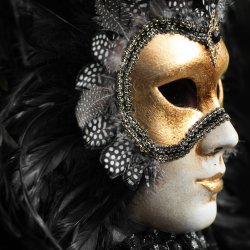
Indo-American Arts Council proudly presents the Erasing Borders Dance Festival from September 20-27, 2020 at 8:30pm EST each day on Facebook Live at facebook.com/iaac.us. For the twelfth year of the Erasing Borders Dance Festival, IAAC has expanded the event. For the first time, eleven artists trained in Indian dance forms from across the world will be brought together in a virtual borderless festival. Details are available at iaac.us/erasing-borders-dance-festival-2020/.
Deepsikha Chatterjee, Festival Director stated, "Moving to a virtual format has its own artistic challenges, but we believe it opened up many possibilities. Our artists are from across the world, representing many of India's dance forms. Bringing them together on an online platform was not only the most responsible and exciting way of showcasing their work but also displaying the virtuosity of diversity."
Sunday, September 20, 2020
Shambhu Nath Karmakar/Ashpara Care Club (Purulia Chhau)
Monday, September 21, 2020
Neha Mondal Chakravarty (Kalakshetra Bharatanatyam)
Krishnakshi Kashyap (Sattriya)
Tuesday, September 22, 2020
Ganesh Vasudeva (Bharatanatyam)
Wednesday, September 23, 2020
Divyaa Unni (Bharatanatyam)
Arun Mathai (Bharatanatyam)
Thursday, September 24, 2020
Sandhya Raju (Kuchipudi)
Friday, September 25, 2020
Damir Tasmagambetov (Kalakshetra Bharatanatyam)
Barkha Patel (Contemporary Kathak)
Saturday, September 26, 2020
Mesma Belsaré (Shilpa Natana)
Sunday, September 27, 2020
Vishwakiran Nambi (Contemporary)
Workshops by Nahid Siddiqui (Sufi Kathak)
The Festival dancers, turned away from traditional performance spaces, take the time to reflect, activate, and energize through other forms of healing. Mesma Belsaré seeks inspiration in the fluid lines of India's ancient architecture while Singapore-based Neha Mondal Chakravarty meditates on a tiny seed sprouting into the fullness of womanhood in Bharatanatyam. Vishwakiran Nambi collects his contemporary group in the urbanscape of Bengalaru to use their bodies in deeply felt and original ways. Arun Mathai draws power and energy from The Great God Shiva against the Black Lives protests in US for his Bharatanatyam performance. New Yorker Damir Tasmagambetov from Kazakhstan, trained in Kalakshetra Bharatanatyam in India bridges many cultures, and concludes his creative presentation through a prayer for Shanti or peace. US based Kathak dancer Barkha Patel is nourished by her week-long walk in Gujarat in prayers for Goddess Bahuchara Maa, a deity for the transgender community in India. Divyaa Unni in Bharatanatyam depicts the unusually calm Goddess Kalika, who appears with neem leaves and holy water this one time to bring balance and tranquility back. Kuchipudi dancer Sandhya Raju's solo presents Lord Krishna, the one who lifted the Govardhan mountain to provide much needed shelter. Her Tarangam dance piece on a brass plate, built through years of training provides much needed charm. Ganesh Vasudeva's Bharatanatyam depicts the Ganga River flowing down from the icy Himalayas, believed to be Lord Shiva's locks of hair, into nourishing rivers and streams. Assam's Sattriya dancer and social entrepreneur Krishnakshi Kashyap reflect on the centuries old meditative performances of the region while Purulia Chhau artist Shambhu Nath Karmakar marches with his ensemble in the traditional acrobatic martial art form to show Goddess Durga vanquishing Mahishasur, the bull demon to restore peace and prosperity
About the Performances
Mahisasur Mardini, performed by Shambhu Nath Karmakar A traditional piece in the Purulia Chhau repertoire, this ensemble number introduces the all-powerful Goddess Durga (demon Mahisasur slayer) and her family as she vanquishes the evil buffalo demon. Each of the members of the family, Gods Ganesha, Kartik with his peacock companion, the great god Shiva, Goddesses Laksmi, Saraswati, and Durga and her lion companion enter the playing space, supported by the percussion of the Dhamsa drum, dhol drum, and the shehnai pipe. They show off their acrobatic process through leaps, jumps, and somersaults. Then comes the buffalo demon with his retinue of minor demons causing much destruction. Goddess Durga activates her omnipotent energy to tackle the demon. After a display of their strengths, good prevails over evil and the buffalo demon and his aides succumb to divine power. The Godly family can now assemble and shower their blessings on the earthly devotees. This piece is popular in the Bengali Durga puja circuit in the months of September and October.
Sukriti, performed by Neha Mondal Chakravarty A woman who is born, like a seed within the depths of earth that has millions of possibilities waiting to start spreading its roots across the earth and reaching towards the sky. But not yet, as it awaits the perfect conditions like moisture which is karuna/compassion to nurture those possibilities. And then she rises like a million suns, protecting the world and its beings. A mother knows no bound, allowing the compassion to flow as her natural instinct. She also weeps silently when the human suffers! And when the equilibrium is disturbed in a world that lacks compassion/empathy/love we learn to evolve or co-exist. The presentation shall revolve around Love/compassion/Empathy, an attempt to look through and find references from the present and mythology, from sufi wanderers with their mysticism and philosophy on life, to Krishna, the charmer and forever longing for his love "Radha." The ultimate source of life "Devi", all pervading, and an epitome of compassion. Join her as she attempts to highlight and bring back these virtues, which are gradually being forgotten.
Rama Niranjana, performed by Krishnakshi Kashyap The abhinaya-mimetic piece 'Rama Niranjana' is based on 'Gunamala', a scripture written by the great saint, poet, scholar and social, cultural and religious reformer Mahapurush Srimanta Sankardev in one night at the request of Koch king Nara Narayan in 1552. It is an abridged version of the ten cantos of the 'Bhagawat Purana'- one of Hinduism's eighteen great Puranas, where the poet recounts incidents from Lord Krishna's life. It will depict mythological stories-the lifting of Govardhana mountain, overthrowing Kaliya snake and the ten incarnations of Lord Vishnu. This will be followed by two traditional dance types of Sattriya, the Ojapali and the Bhortal-cymbal dance. The music for this dance is specially recorded for performance using traditional musical instruments like the Khol, Flute, Cymbals and Violin.
Rojaghoria Saali, performed by Krishnakshi Kashyap This is a pure dance number in 'Lashya'-feminine style of Sattriya Dance. In Shankardeva's era and later, Ahom kings patronized the Sattriya culture. The dancers were initially reluctant to perform the traditional dance outside the monasteries but accepted the royal command. They reformed and revised a version of the traditional form for the King's court, thus preserving the original form for the monasteries. Thus, emerged the Rojaghoriya Saali where 'Roja' means king and 'ghor' means house (court/palace), revealing that this dance was performed in the king's palace/court, sometime during the Ahom era in Assam.
Descent of the Ganges, performed by Ganesh Vasudeva
Hindu mythology says Ganges, the river goddess Ganga, originally flowed through the heavens. She was brought to earth by devout Sage Bhagiraths. Goddess Ganga agreed to flow to earth for the benefit of mankind but warned her torrential currents would wash the world away. Upon Bhagirath's request, Shiva put his matted hair in the path of the heavenly river. Ganga in her arrogance, tried to sweep Shiva away. Upon realizing this, Shiva tied her up in his deadlocks. Mythology tells us that upon the request of Bhagiratha, Shiva splits Ganga into many streams. However, in this rendering, the story is imagined differently. Ganga upon realizing that she cannot sweep Shiva away with force, tries her feminine charm on him. She slowly trickles down covering his eyes, nose. When she is about to descend on his lips, Shiva realizes Ganga's pranks, and lets her off gently from his matted locks
In this charming Padam, a young maiden curious about Krishna asks her friend for details about him. She says what kind of man is he? Tell me everything you know about him.
In this Javali, a young bride chides Cupid for shooting flower arrows at her when her beloved husband is not at home.
It's a New Beginning, performed by Divyaa Unni
Humans consider themselves the most significant creation of God. Yet, human greed has constantly overpowered this blessing as humans have looted, disrupted and continuously destroyed this planet.
Surrounded by the fearful dark clouds of uncertainty humans cease to introspect. From deep within shines a divine light, the form of Goddess Kalika-the destroyer of evil forces. The female energy that represents the fullness of time-the changing aspect of nature. Her hands usually carry a demon head and sword, only this time holding neem leaves and holy water. She starts to dance around the world sprinkling holy water on the entire creation. Glancing deep into the eyes of the introspective human, she compassionately sprinkles the holy water on him. White flowers showers from her hand onto his head, on to the rivers, trees, plants and animals. Back in tune with the divine melody and realization; man once again starts to live in harmony with nature.
Shivoham, performed by Arun Mathai
Based on an excerpt from the Skanda Purana, Shivoham, choreographed by Smt. Rama Vaidyanathan and composed by Sri GS Rajan, uses the idiom of dance to experience the presence of Lord Nataraja in the body and soul. "Jeevaha Shivaha. Shivo Jeevaha." Shiva lives in every soul. Shiva is existence.
Shiva is synonymous with the fires of dissolution, but also the primordial drumbeat of creation. While we see both around us on a daily basis, it is hard not to focus solely on the negative, especially in the US, where racially motivated acts of violence happen every day. Just as Shiva maintains balance through the cycles of destruction and creation, we have the ability to overcome the violence of racism and police brutality through protest and social activism. Just as Shiva destroys in order to create, we have the power to dismantle systems of oppression in order to create a more just future. Shiva lives in every being. We are Shiva.
Govardhana Giri Dhara, performed by Sandhya Raju
This is a Kuchipudi Tharangam composed by saint Narayana Theertha and choreographed by Padma Bushan Guru Vempati Chinna Satyam Garu. It is set to Raagamalika and Adhi talam. As a quintessential Kuchipudi solo presentation, the Tharangam is the main act or crux of the recital. The song is in praise of Lord Krishna, whose many attributes are described and praised. Primarily as the one who lifted the Govardhana Mountain with his little finger, to provide shelter to his community against the angry wrath of Lord Indira, who summoned floods and storms against Brindavanam as they chose to do annual prayers to the mountain gods instead of Him.
This story which is enacted in detail is preludes by two more joyous tales of Krishna's life in Brindavanam.
One episode describes his love of milk and how he steals it greedily under the watchful eyes of his mother Yashodhara.
Another piece describes the legend of how he stole the beautiful Gopikas clothes and demands they come out of the water nude and pray to him. Symbolising that he teaches the Gopikas that God doesn't differentiate man or women and there should be no shame or vanity regarding the human body. These episodes are followed by beautiful yet ancient dance jathis using some of the oldest unique steps to the Kuchipudi classical style. The piece concludes with a traditional dance on the brass plate mastered with many years of intense practice.
Invocation: Ganapathi Stuthi, performed by Damir Tasmagambetov
Bala Ganapathi is an aspect of the Hindu God Ganesha, the elephant-headed of wisdom and fortune, depicted as a child.
The beautiful and beloved son of Shiva and Parvathi, and whose brother is Lord Muruga. You are destroyer of all the obstacles, and you are full of mercy and compassion. We bow to you O'Lord Bala Ganapathi!
Main piece: Kumarasambhavam, performed by Damir Tasmagambetov
Kumarasambhavam is widely regarded as one of Kalidasa's finest works. This keertanam is an extract from kumarasambavams 7th Sarga, which describes Lord Shiva's preparation for marriage. Ragam: Bibhas, Talam: Adi, Music composer : Sree Madhup Mudgal, Choreography: Smt. Leela Samson.
Conclusion: Shanti Path - mantra for the well being of all, performed by Damir Tasmagambetov Those verses taken from Shanti Path, which is a mantra of Peace, Harmony and Happiness. May peace radiate sky as well in the vast ethereal space everywhere. May peace flow over the whole universe. And may there always exist in all peace and happiness.
Aravani, performed by Barkha Patel
Aravani (transgender/hijrah) is a male identifying as female. 'Prayers of an Aravani' is about a woman rejoicing the outlawing of section 377 of the Indian Constitution. As she sings a prayer to Bahuchara Maa, a goddess central to Indian transgender community, this Aravani recalls her journey of being ostracized by her family, searching for a sense of belonging and reigniting a flame within to be her unabashed self.
This work was inspired by a week-long walking pilgrimage Barkha participated in from her hometown in Gujarat to the temple of Goddess Bahuchara. After being pulled away from an interaction with a local hijrah on temple grounds, Barkha began to realize that while the worship of aGoddess helps to include aravanis/hijras, they are still largely excluded within the larger social context of Indian society.
Still under textual research, this work shares the emotional experience of a hijrah. Mindful of the fact that I, myself, am not a hijrah, my intention with this work is to bring to the forefront the importance of a community that is constantly marginalized by cultural stigma.
Shilpa Natana (The Dancing Sculptures), performed by Mesma Belsaré
Choreographed by NYC-based Maya Kulkarni, Shilpa Natana (The Dancing Sculptures) is rooted in the Sanskrit texts: the Natyashastra, the Abhinayadarpana and the Shilpa Shastra. This dance-genre steps out of the traditional Indian classical repertory. Chola, Mathura and Gandhara sculptures in addition to the Ajanta cave paintings inspire not only the choreography, but also the āhārya (costume, hair and make-up) of the dancer. The New York Times describes the dance as a "virtuoso number."
The repertory includes a refreshing interpretation of Līlā Shuka's verses from the classic Krishnakaranāmritam and a dance inspired by Ardhanārīśwara that establishes parallels between the half-Śiva-half-Umā iconography and the Nāsadīya Sukta (Hymn of Creation) in the Rig Veda (c.1700 B.C.E.).
Pyre, performed by Vishwakiran Nambi
We are just like different rays of sunlight which ultimately originates in the sun, and so even our destiny is to be together. But with twists and turns of life we end up building walls and burning bridges. We go through deep internal journeys that find resonance in the spirit of a friend or stranger's witness. The humanity that inevitably binds us, also makes us fellow pilgrims in these purposes seeking intimate implorations that are but pilgrimages.
Pilgrimages invariably also have a test to clear in view of purifying the spirit. They have the capacity to turn one's spirit inside out and shatter hopes, all within its tender embrace.
And this test - the test of fire revisits a pilgrim at various instances throughout one's journey in search of meaning. The quantum of anguish, pain, doubt and determination is physically experienced not necessarily by walking on pyre that is tangible, but also a pyre that exists inside one's being. To be ready to walk that pyre means to be ready to take the responsibility of the choice of meaning you observe after, perhaps, even completing a journey that you needn't had to make.
About the Artists
Mesma Belsaré (Shilpa Natana) is a dancer, painter and actor, described by The New York Times as "a tour de force...a true act of transcendence...", "as mesmerizing as staring into the heart of a fire", by The Dance Current Magazine, and with a "capacity for intense involvement" by The Hindu. Belsaré studied Bharatanātyam in India under Sri Shankar Hombal at the Kalāpadma Academy, under Padmashri Geeta Chandran at the Nātya Vriksha Academy of Performing Arts and continues learning with New York based Maya Kulkarni, and creating new dance works inspired by classical visual arts/architecture, Sanskrit literature and Greek mythology/philosophy. Her solos were seen at The Lincoln Center, Asia Society, Alvin Ailey (NYC), The Lincoln Theater (Washington D.C.), Siri Fort (New Delhi), The Harbourfront Centre (Toronto, Canada), and MFA Boston among others.
With a her classical Indian training in music, dance, painting, theater, and both Indian and European aesthetics, her work derives inspiration from performing and visual arts alike. Belsaré is also an art educator and curates educational programs based on contemporary art. She is recipient of the Cambridge Arts Council's Artist-Grant, the Government of India's Sāhitya Kalā Parishad scholarship for advanced training in Bharatanātyam and Indian classical music, and the New England Foundation for the Arts DANCE grant. Invited artist-residencies and talks include Georgetown University (2019), UC Berkeley (2019), California Institute of Integral Studies (2019), Drexel University (2019), William Paterson University (2019), MIT Cambridge, MA (2019) and Harvard University, Cambridge, MA (2019/2010) among several others. More information is available at www.mesmabelsare.com.
Krishnakshi Kashyap (Sattriya) is a Sattriya dancer, educator, choreographer, cultural and social ideapreneur. Sattriya dance is 500 year old living tradition practiced in Sattras-monsatic communities of Assam.
A recipient of the Young Talent Artiste Award by NEZCC, Ministry of Culture, Govt of India, she was conferred the Dalmia Cement Young Achiever's Award 2020 for her exceptional achievements in the field of art and culture. As a practitioner-performer, she promotes Sattriya Dance, the 600 years old living tradition of Assam, a state in North East India. Trained under renowned Gurus Shri Ramkrishna Talukdar, Shri Jatin Goswami and Smt. Indira P. P Bora, Krishnakshi has performed Sattriya on various prestigious platforms across the country. She is a graded artiste under Prasar Bharati, India's largest public broadcasting agency. Under her initiative 'Empowerment through Arts', she teaches Sattriya to under privileged girls, adding color to their lives and empowering them. Krishnakshi has started an initiative, 'Promote the Heritage Culture - Sattriya' and conducts Sattriya online workshops.
Arun Mathai (Bharatanatyam) was first exposed to Bharatanatyam while watching his older sister in class, and would often imitate the moves he witnessed, using the coffee table as his stage. Encouraged by his parents he started studying at Kala Vandana Dance Center, in San Jose, California, under the rigorous but loving guidance of his guru, Smt. Sundara Swaminathan.
After obtaining his BS in Business Administration Arun joined LA-based Blue13 Dance Company and soon became a principal dancer. He also began traveling abroad to study with respected teachers and perform. In addition to his guru, some of the renowned instructors Arun studies with include: Smt. KP Yasodha, Smt Rama Vaidyanathan, Smt. Bragha Bessell, Sri Hari Padman, and Smt. Viji Prakash.
Currently a freelance artist, Arun is also the Budget Manager at LACMA, is pursuing his MBA at UCLA Anderson, and is a part-time lecturer at USC's Glorya Kaufman School of Dance.
Neha Mondal Chakravarty (Kalakshetra Bharatanatyam) hailing from India, New Delhi, is a Bharatanatyam performer, teacher and choreographer, who currently resides in Singapore. An alumna of Kalakshetra Foundation, Chennai, Neha was trained by stalwarts like Shri A. Janardhanan, Sheejith Krishna, Smt. Jyotsana Menon and Ms. Leela Samson. Her experience with Kalakshetra's repertory company, under the guidance of Leela Samson transformed her into a subtle and thinking dancer. Neha worked as an empaneled "A" grade artist with the Ministry Of Information and Broadcasting, New Delhi. Her inclination towards body awareness led her to train rigorously in jazz, contemporary dance, and somatic techniques. She received junior and senior scholarships in Bharatanatyam from NCERT and Ministry Of Culture. Neha moved with her husband to Kuala Lumpur in 2014 and later Singapore. Neha has performed extensively in South East Asia, USA, UK and Europe. She now trains serious practitioners of the art form
Vishwakiran Nambi (Contemporary) is a performer, choreographer, dance filmmaker, academic and Director of LOKA Studio for Movement Practices and the driving force behind Vishwakiran Nambi Dance Education (VNDE). He was the principal dancer, head of training and one of the principal choreographers of 'Nritarutya Dance Company' for over 10 years. His training is diverse ranging from Indian classical forms to Indian folk and martial dance forms. Though his foundation is in contemporary dance and Bharatanatyam, he constantly trains and explores the folk dimensions of South Indian dance and trains extensively in martial forms. He has been a solo performer for over 5 years now and has choreographed and presented his solo 'Stone Unturned' at the prestigious ADA Rangamandira in Bangalore as part of ADHYAYA 2017. He has, from then onward, choreographed multiple short pieces for Nritarutya and later independently created his own repertoire. His vision is to explore the possibilities in Indian dance framework particularly with the vast folk landscape. His creations are mostly experiences of regional authenticities and existential peculiarities.
Shambhu Nath Karmakar (Ashpara Care Club/Purulia Chhau) is a Purulia Chhau artist trained in the region's traditional martial and acrobatic dance form under guru Dhananjay Mahato. He has received national scholarships in dance from Ministry of Culture, New Delhi. He is involved in Purulia Chhau performance, training, workshops, exhibitions, and competitions. He and his group Ashpara Seva Jatna Chhau Training Center has been invited to various national and international festivals including Japan, Srilanka, Bangladesh and others. He has established Seva Jatna Chhau Institution to teach the youth this martial dance form and to deepen their connections to their cultural roots.
Barkha Patel (Contemporary Kathak Company) is a touring artist who has performed at dance festivals in India to Jacob's Pillow Inside/Out series in the U.S. She completed a choreographic fellowship with Jersey Moves/New Jersey Performing Arts Center. Currently, Barkha is working on her first, full evening ensemble work called Mukta, A Woman Liberated. Recently, Barkha received a 2020 Fellowship from the New Jersey State Council on the Arts and is a mentee of Dance/USA Institute for Leadership. Barkha teaches kathak to young and adult students in NYC/NJ and now across the world via Zoom. Barkha co-founded a Kathak meetup group, an inclusive space for Kathak dancers to practice and discuss crucial topics to the art form.
Sandhya Raju (Kuchipudi) is a Kuchipudi dancer from Hyderabad. She has learnt the dance form from the legendary dance maestro Padma Bushan Dr. Vempati Chinna Satyam and his senior disciple Shri Kishore Mosalikanti Garu. She presented Kuchipudi as part of her Guru's troupe as well as a solo artist. She is the founder director if Nishrinkala Dance Academy in Hyderabad. Beyond Kuchipudi dance, she has also explored other mediums of artistic expression through her acting in three short films. Her most notable one is "Natyam" on YouTube. She has acted in a Malayalam Feature Film and is currently filming for a dance based feature film where she plays the lead character of an Indian Classical Dancer.
Nahid Siddiqui (Sufi Kathak) is a Kathak artist trained by Pandit Birju Maharaj and Baba Maharaj drawing from the aesthetics of Punjab and Lahore. During a phase of cultural turmoil, she was exiled in the UK, where she taught and lectured at institutions including the University of Surrey, Bharatiya Vidya Bhavan, and others. She has choreographed many works and created a Gharana/style combining Kathak aesthetics and Sufi spirituality.
Damir Tasmagambetov (Kalakshetra Bharatanatyam) is from the city of Almaty, Kazakhstan, in the heart of Central Asia. Damir holds a Bachelor and M.A degree from two Universities of Dance-one for each discipline in their respective country of origins. He completed his studies at the Kalakshetra Foundation, India with a 1st class Diploma in Bharatanatyam. He continued to expand his knowledge in Indian Classical Dance, graduating from The University of Madras to complete his master's degree in Bharatanatyam in 2017. He has been selected by Indian Council for Cultural Relations (ICCR) as an Empaneled artist. By special invitation Damir was selected to become a Member of the International Dance Council (CID) under UNESCO in Paris, France. As a passionate dancer he has given numerous solo and group performances at major dance celebrations and prestigious platforms in India, Kazakhstan, Kyrgyzstan and the USA. Currently based in Brooklyn, New York, Damir is committed to spreading a deep understanding of Indian classical traditions through teaching in the USA. As an educator he has given lectures, demonstrations and workshops in both museums and schools throughout the NYC area. He strives to train the next generation of Bharatanatyam artists who share his passion and joy for the art, helping them develop the skills necessary to explore new possibilities within this art in today's world.
Divyaa Unni (Bharatanatyam) is an internationally recognized dancer, teacher and choreographer. She started learning dance at the tender age of three from highly respected and diverse dance gurus Kalamadalam Gopinath and RLV Anil Kumar. She was crowned "Kalathilakam" in the annual state-wide youth festival conducted by the Government of Kerala in the year 1990 and 1992. Divyaa's dance was featured in Doordarshan at the age of 6 and subsequently she presented dance recitals of Bharatanatyam, Mohiniyattam and folk dances every year from 1987 to 1994. Her potential in acting was realized due to her achievements in dance following which, at the age of 13, she was offered the leading role in a Malayalam movie in the year 1995. Subsequently, Divyaa, has acted as a female lead in more than 50 movies, including Tamil, Kannada and Telegu movies. Some of her recent and notable productions are "Tara" which was part of the Panchakanya project by Tat Tvam Asi sabha in Austin, Texas (2017); and "Vande Janani - celebrating motherhood" and Thousand names of a Goddess (2019). Divyaa is known to move the audience with her Abhinaya style of Dance, without losing the technical purity of Bharatanatyam.
Ganesh Vasudeva (Bharatanatyam) has been training in Bharatanatyam for more than 30 years. In the past few years Ganesh has choreographed and presented his own work to critical acclaim. More information can be found for Ganesh at www.ganeshvasudeva.com/.
About the Erasing Borders Dance Festival
The Erasing Borders Dance Festival of the Indo-American Arts Council (IAAC) invites dancers, dance companies and choreographers across the world to present works of artistic excellence sharing movement, heritage and inspiration from the Indian subcontinent. The festival is curated for the New York City public and can now be viewed globally in its virtual edition.
About the Indo-American Arts Council
The IAAC supports all the artistic disciplines in classical, fusion, folk and innovative forms influenced by the arts of India. We work cooperatively with colleagues around the United States to broaden our collective audiences and to create a network for shared information, resources and funding. Our focus is to help artists and art organizations in North America as well as to facilitate artists from India to exhibit, perform and produce their work here. The IAAC is a 501(c)(3) tax-exempt organization. All donations are tax-deductible to the fullest extent allowable by law. For information please visit www.iaac.us.
culturalattache.co
Erasing Borders Dance Festival
September 18th – September 20th
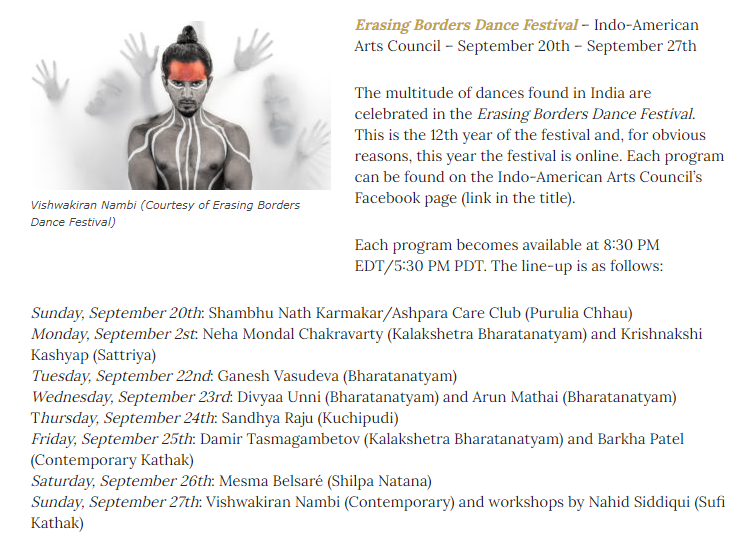
URL: https://culturalattache.co/2020/09/18/best-bets-at-home-september-18th-september-20th/
timeout.com
Indo-American Arts Council Presents a Virtual Erasing Borders Dance Festival
September 17 2020
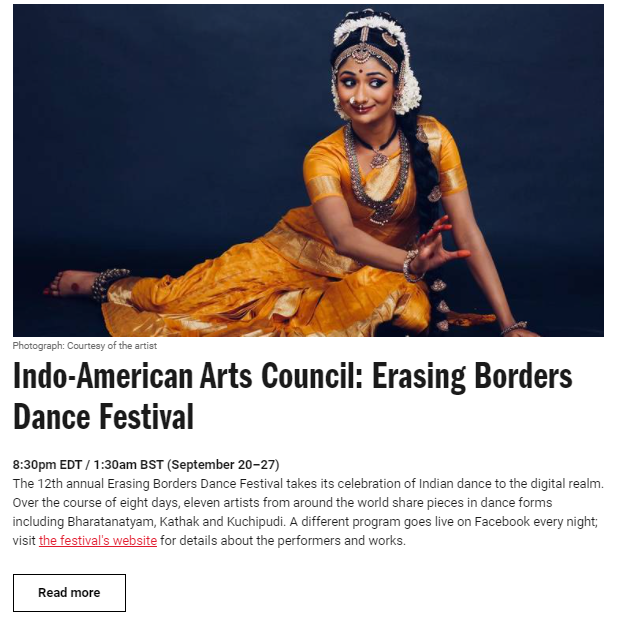
DJPAS
DJPAS
September 7, 2020

donyc
INDO-AMERICAN ARTS COUNCIL PRESENTS A VIRTUAL ERASING BORDERS DANCE FESTIVAL
SUN SEP 20, 2020

evensi.com
Indo-American Arts Council Presents a Virtual Erasing Borders Dance Festival
September 7, 2020
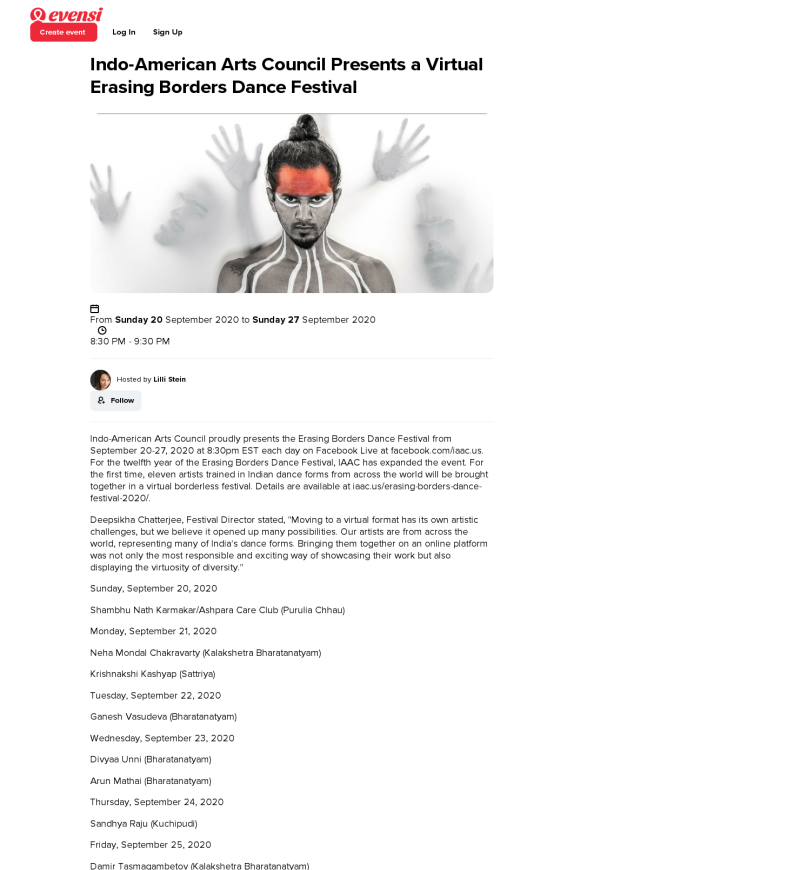
eventsnearhere.com
Indo-American Arts Council Presents a Virtual Erasing Borders Festival
September 7, 2020

ezevent.com
Indo-American Arts Council Virtual Erasing Borders Dance Festival
Sunday, Sep 20, 2020
New York, NY , United States of America
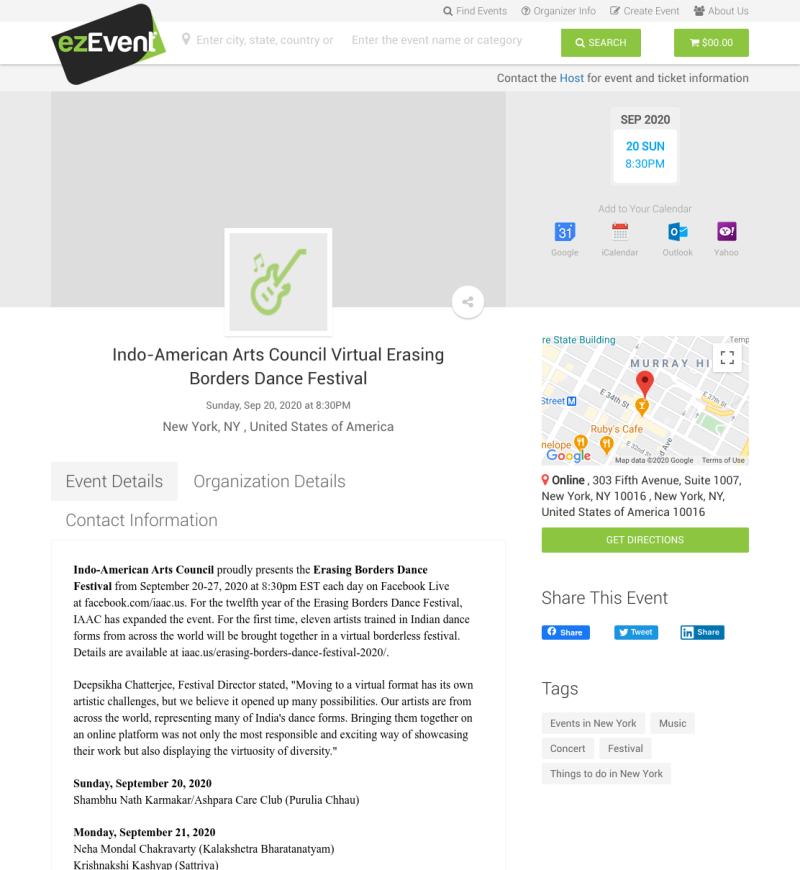
fusicology.com
Indo-American Arts Council Presents a Virtual Erasing Borders Dance Festival
Sunday, Sep 20, 2020
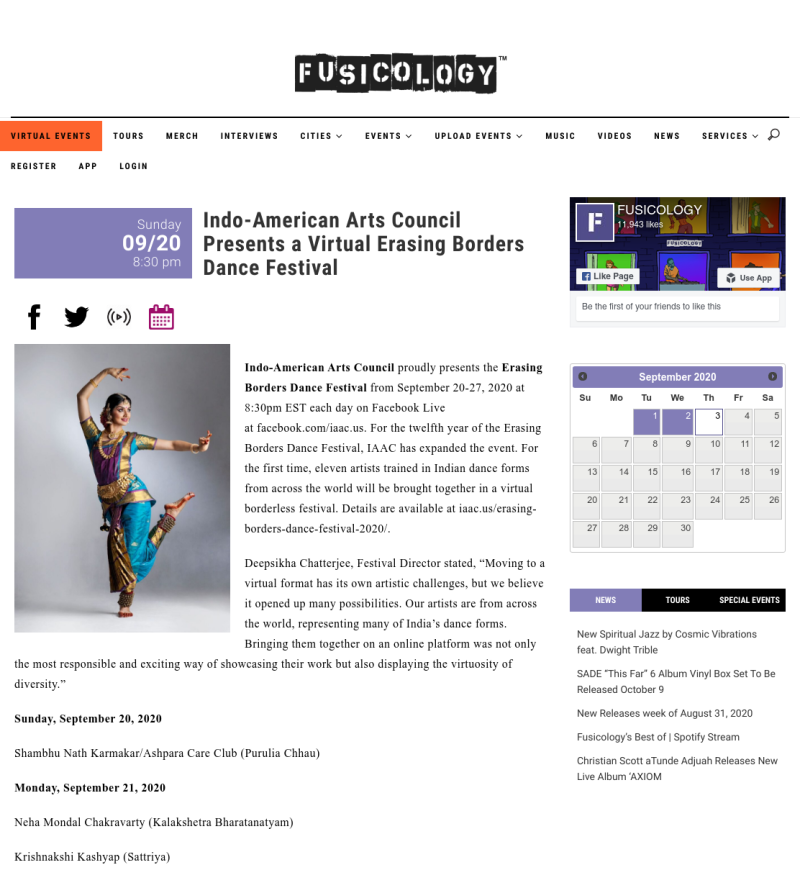
newyorkirisharts.com
Indo-American Arts Council Presents a Virtual Erasing Borders Dance Festival
September 20 @ 8:30 pm
September 27 @ 9:30 pm
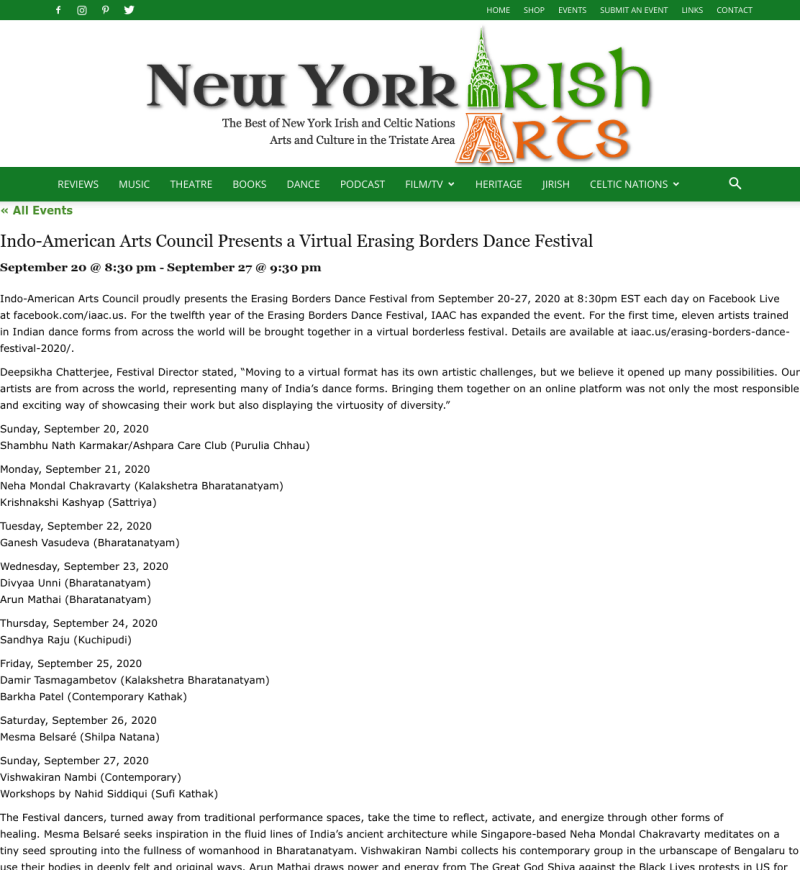
nightout.com
Indo-American Arts Council Presents a Virtual Erasing Borders Dance Festival
Sunday, September 20
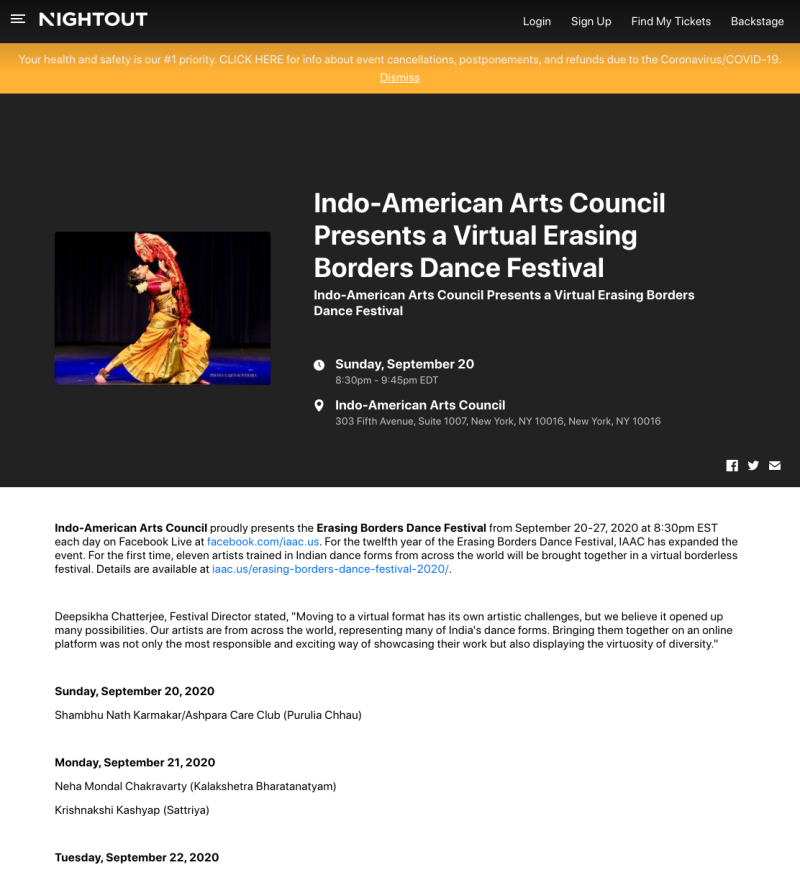
nyc.com
Indo-American Arts Council Presents a Virtual Erasing Borders Dance Festival
September 20, Sunday 8:30PM

URL: https://www.nyc.com/events/indoamerican_arts_council_virtual_festival.1626750/
StageBuddy.com
Indo-American Arts Council Presents a Virtual Erasing Borders Dance Festival
September 20, Sunday 8:30PM

Theater Online
Indo-American Arts Council Presents a Virtual Erasing Borders Dance Festival
September 20, Sunday 8:30PM
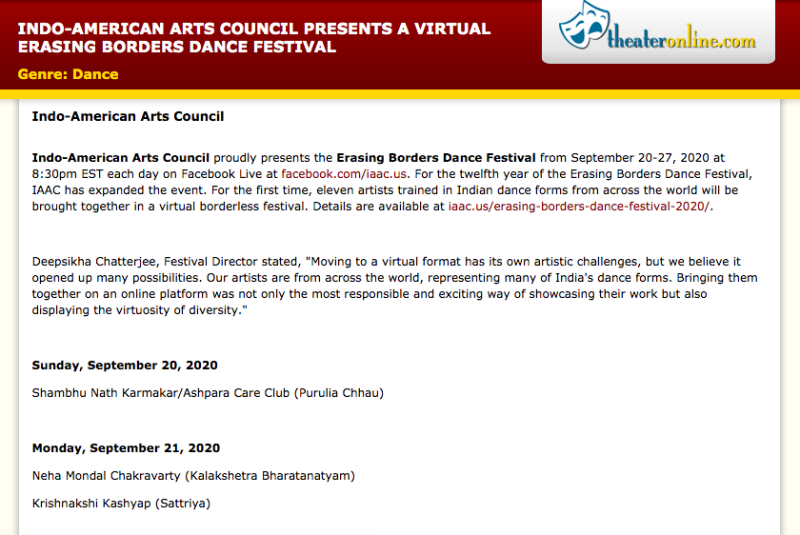
Theater Scene
Indo-American Arts Council Presents a Virtual Erasing Borders Dance Festival
September 20, Sunday 8:30PM
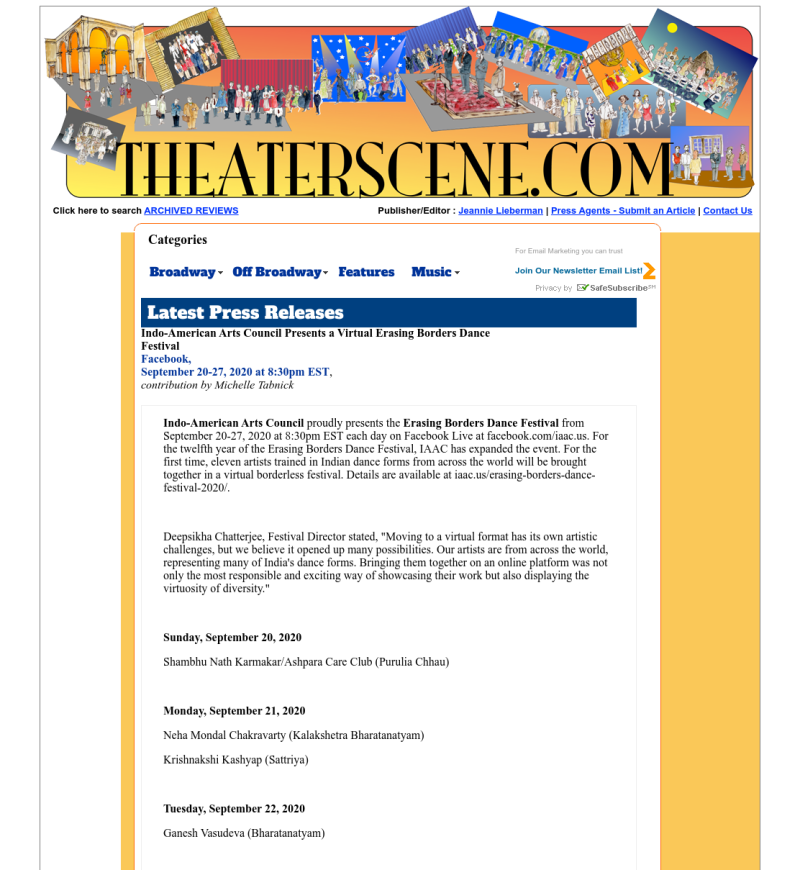
URL: http://theaterscene.com/press-releases-detail.php?pr_id=1326
Yelp
Indo-American Arts Council Presents a Virtual Erasing Borders Dance Festival
September 20, Sunday 8:30PM

dance-enthusiast.com
Indo-American Arts Council Presents a Virtual Erasing Borders Dance Festival
BroadwayWorld.com
Indo-American Arts Council Presents a Virtual Erasing Borders Dance Festival
September 20, Sunday 8:30PM

URL: https://michelletabnickpr.coveragebook.com/b/b5b3e74f114dacab
EB DANCE FESTIVAL 2020
FB & INSTA STORY
Shambhu Nath Karmakar/Ashpara Care Club—Purulia Chhau
Sept 20, 2020, Sunday
Neha Mondal Chakravarty/Kalakshetra Bharatanatyam
Krishnakshi Kashyap—Sattriya
Sept 21, 2020, Monday
Ganesh Vasudeva—Bharatanatyam
Sept 22, 2020, Tuesday
Divyaa Unni—Bharatanatyam
Arun Mathai—Bharatanatyam
Sept 23, 2020, Wednesday
Damir Tasmagambetov/Kalakshetra Bharatanatyam
Barkha Patel—Contemporary Kathak
Sept 25, 2020, Friday
Mesma Belsaré —Shilpa Natana
Sept 26, 2020, Saturday
Vishwakiran Nambi—Contemporary
Sept 27, 2020, Sunday
Curator Bios
Deepsikha Chatterjee: Dance Director
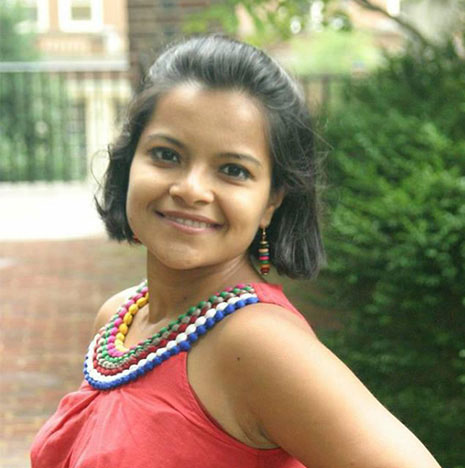
Deepsikha Chatterjee is a tenured faculty of Theatre at Hunter College CUNY where she enjoys teaching a diverse student body. She received her undergraduate degrees from University of Madras and National Institute of Fashion Technology before moving to the US for her MFA in Costume Design from Florida State University.Currently she is pursuing her PhD in Theatre and Performance from CUNY Graduate Center.Her costume design for Butoh Medea and Hide Your Fires received the Best Costume Design award at United Solo in 2014 and 2017 respectively. Her designs have been seen recently at Barnard College, Mabou Mines, Rattlestick Playwrights Theatre, Women’s Project, New York Musical Festival, Drive East, United Solo, Pan Asia Repertory, and Capital Fringe.
She researches costumes and masks for Indian performance and has received notable grants for this work. Her presentations have been seen at conferences including USITT, Costume Society of America, and the Rubin Museum of Art in New York City. She has published articles on Indian and Asian theatre, and Indian fashion. Since 2017 she has served as the dance director for Indo-American Arts Council’s Erasing Borders Dance Festival bringing international dancers to the New York stage.
Uttara Asha Coorlawala: Curator
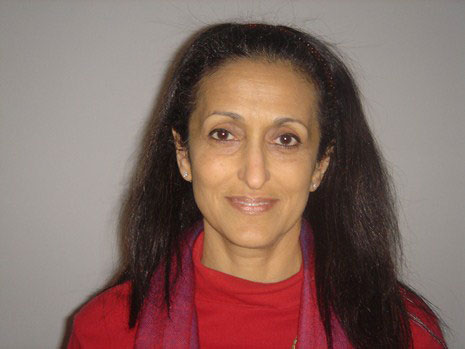
Uttara Asha Coorlawala currently teaches in the dance program at Barnard College/Columbia University and serves as Curator for Erasing Borders--the annual Festival Of Indian Dance. Had previously also taught at Alvin-Ailey- Fordham University Dance Program, Long Island University's C.W. Post Campus, and at Princeton University, NJ. Earlier as a dancer, her solo show, (1973-87) brought modern dance, BharataNatyam and yoga, to stages of India, Europe, East Europe, Japan and the United States. For her pioneering choreography she was recently awarded the Sangeet Natak Akademi national award. (India) Uttara also served on various global dance research (CORD) and educational (IB) Committees, and as Performing Arts advisor to the late Prime Minister Rajiv Gandhi, and at the National Center of Performing Arts, Mumbai.
Awards for writing include AHRB Fellowship for South Asian Dance Research, London, The Graduate Research Award from CORD, USA, the Homi Bhabha Fellowship, India, a Ford Foundation research project (USA) on changing demographies of cultures in the U.S. and an award to study choreography from the Asian Cultural Council.
Currently, she is even more invested in the ongoing global re-flows of body knowledges.
Parul Shah: co-curator
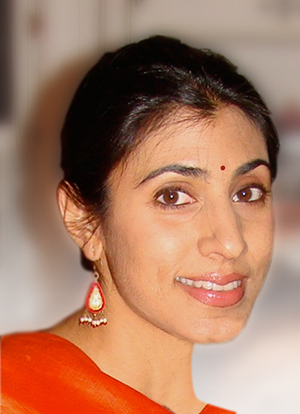
Artistic director, Parul Shah of the Parul Shah Dance Company is an internationally acclaimed Kathak and contemporary dancer and choreographer whose work is expanding the classical medium beyond cultural boundaries. With a dedication to excellence, Shah preserves the form’s aesthetic integrity while exploring contemporary stories and questions around belonging, identity, and empathy. Her work aims to create shared experiences and lasting connections between performers and audiences.
Sruthi Mohan: co-curator

Sruthi Mohan is the Founder and Creative Director of Tat Tvam Asi, a boutique art organization in Austin, Texas, created specifically to curate and present works of internationally acclaimed Indian classical dancers touring the US.
An active and passionate community organizer, with more than a decade of organizational experience, she currently serves as the Cultural Committee Chair of the Austin Hindu Temple and has been instrumental in creating various cultural outreach initiatives that aim to showcase the spiritual beauty of Indian classical dance and other temple arts.
An accomplished and well trained classical dancer who started training at the age of three, she continues to perform to a diverse international audience. She also shares her passion for dance by writing about dance, appearing on radio and TV talk shows to promote and educate a wide and diverse audience about Indian Classical Dance.
Apart from being a dancer and a dance presenter she is also a Co curator for the Erasing Borders Dance Festival, New York.
Dipashreya Sur - Erasing Borders 2020 Festival Intern
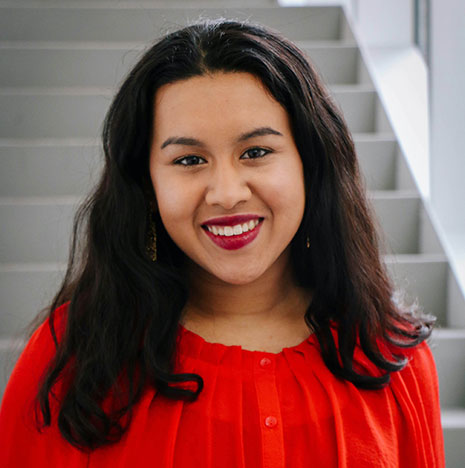
Dipashreya Sur is a rising sophomore at Barnard College of Columbia University majoring in Mathematical Sciences and History and Theory of Architecture. She has been learning Kathak, an Indian Classical Dance form, in the Lucknow Gharana for more than 14 years. On campus she dances with Columbia Taal, an Indian Classical Fusion Dance team. Though Dance originally started off as an extracurricular activity introduced by her parents, overtime it became her passion. Over the years she has also explored dance styles ranging from Contemporary to Afro Cuban. She is honored to be a part of this year’s Erasing Borders Festival.

